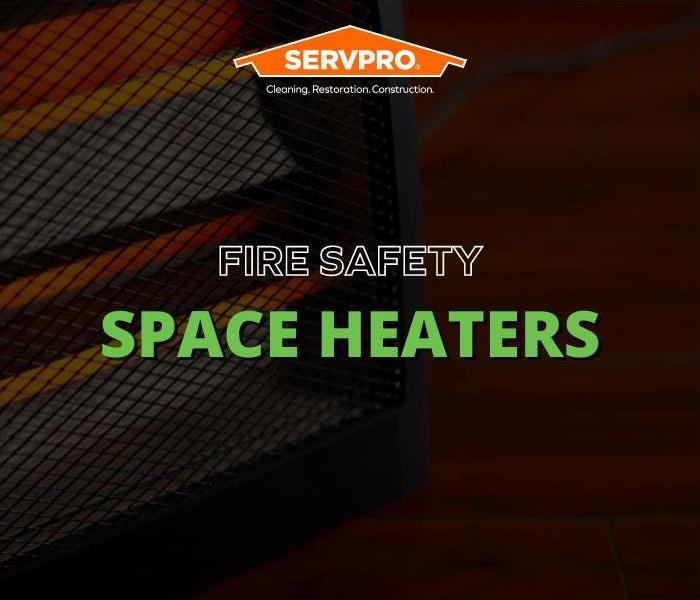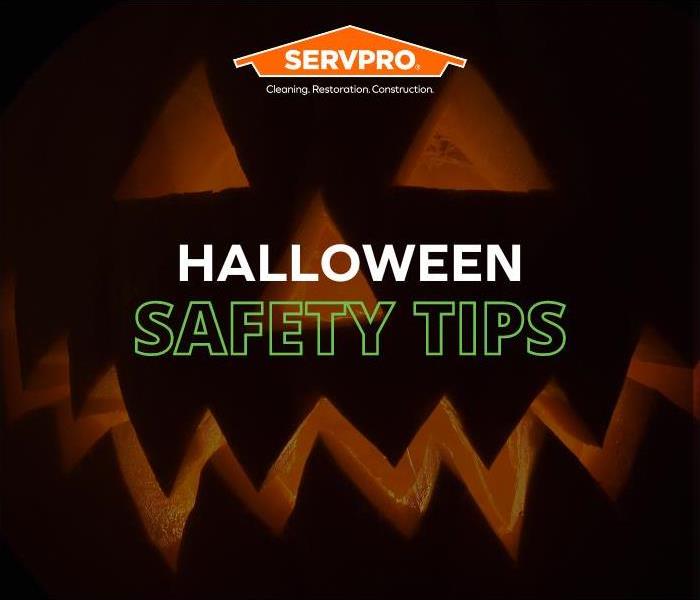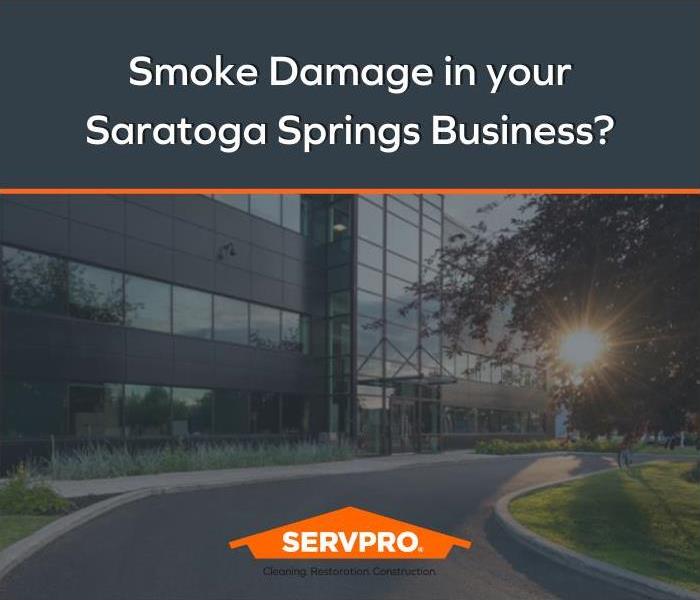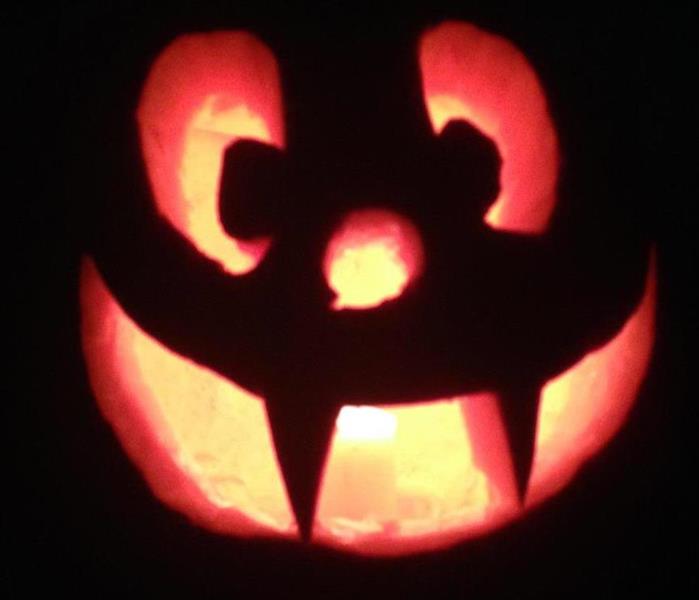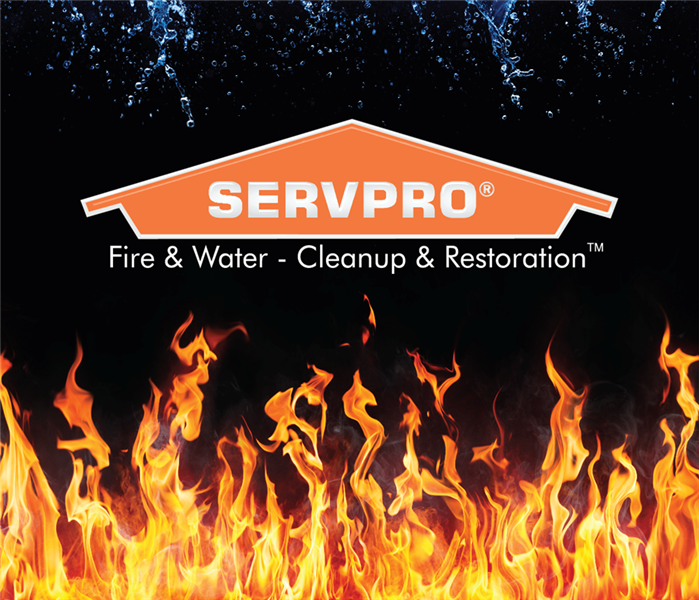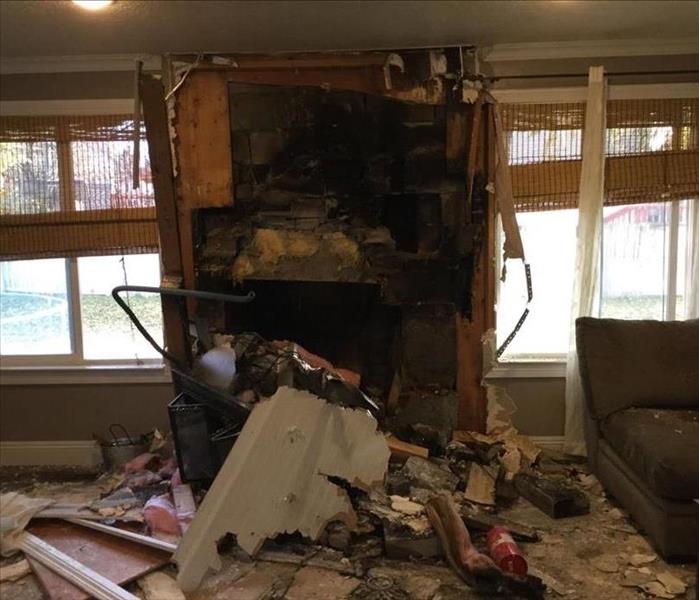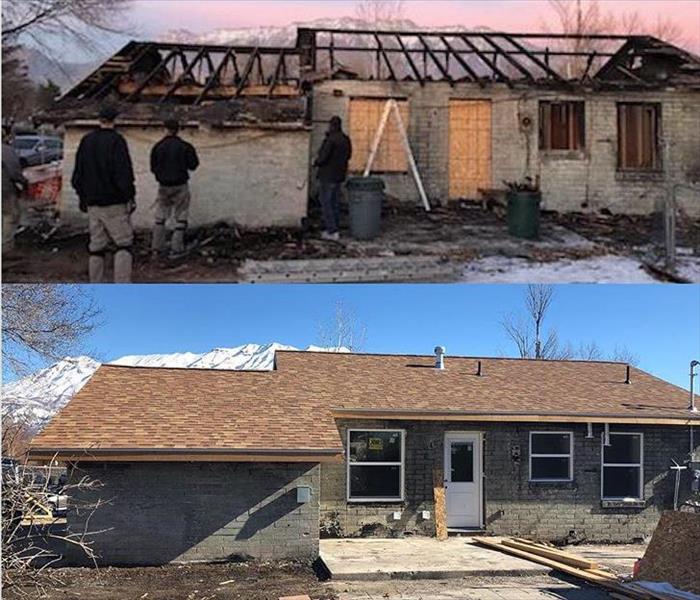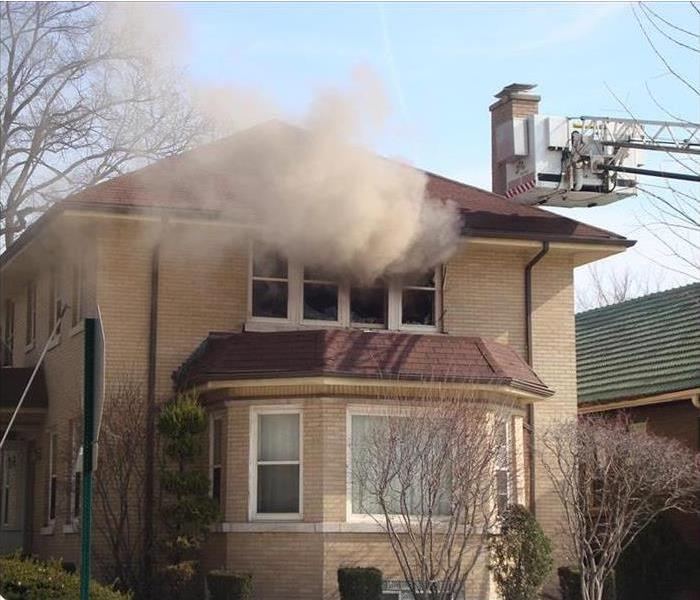Recent Fire Damage Posts
Steps to Take After a Fire in Your Home
7/25/2024 (Permalink)
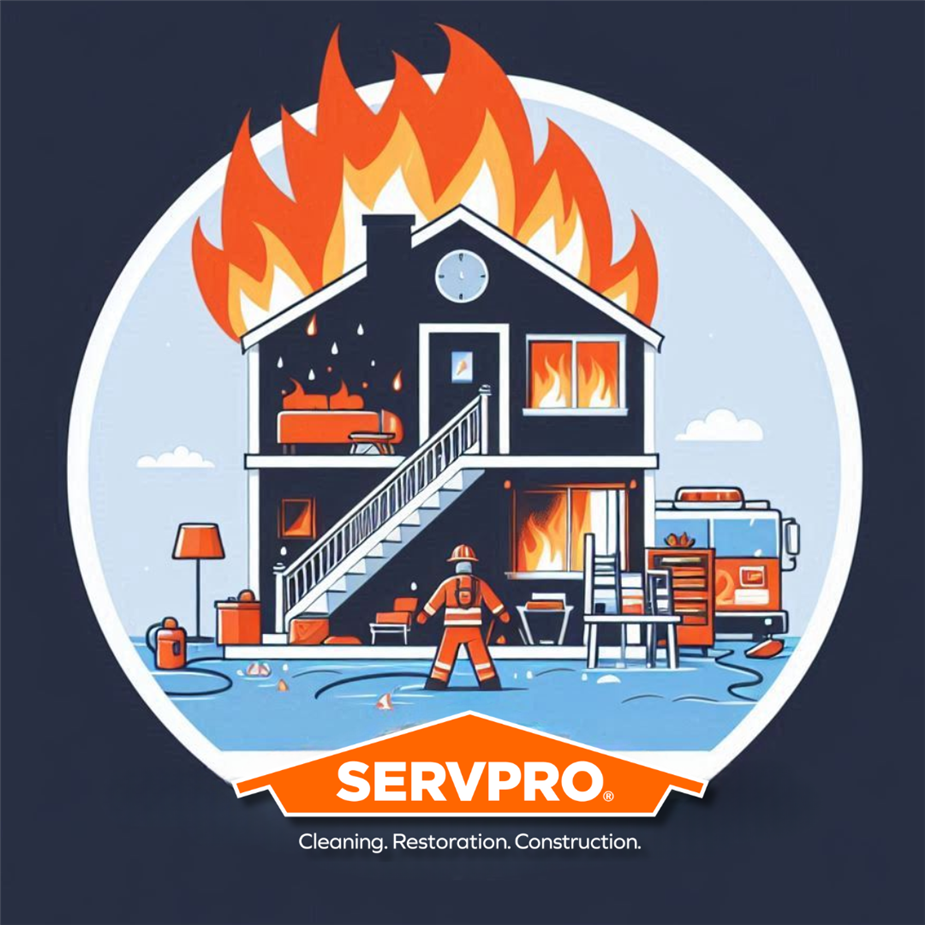 Steps to Take After a Fire in Your Home
Steps to Take After a Fire in Your Home
SERVPRO® of Utah County
Steps to Take After a Fire in Your Home
- Ensure Safety First
- Evacuate: Leave the premises immediately if you haven’t already.
- Contact Emergency Services: Call 911 to report the fire and seek medical attention if needed.
- Contact Your Insurance Provider
- Notify your insurance company about the fire incident.
- Document the damage with photos or videos for your claim.
- Secure the Property
- Board-Up Services: Arrange for professionals to secure openings (windows, doors) to prevent further damage.
- Roof Tarping: Cover any holes in the roof to prevent water intrusion.
- Assess Damage and Restoration
- Fire Damage Assessment: Professionals will evaluate the extent of fire and smoke damage.
- Water Removal: If firefighting efforts caused water damage, address it promptly.
- Soot and Smoke Odor Removal: Clean affected areas thoroughly.
- Coordinate Restoration Services
- Highly-Trained Technicians: SERVPRO’s experts will restore your property.
- Insurance Claim Process: They’ll assist with paperwork for a smoother experience.
- Residential and Commercial Services: Restoration for both home and business spaces.
- Additional Considerations
- Document Restoration: Salvage important papers damaged by fire or water.
- Smoke Odor Removal: Address lingering smells effectively.
- Specialty Cleaning: Restore items like carpets, upholstery, and walls.
Remember, SERVPRO of Utah County is available 24/7 for fire damage restoration2. They specialize in helping you recover after a fire, ensuring your property is safe and restored. Stay safe! ????
Smoke and Soot Cleanup Fire Damage
1/15/2024 (Permalink)
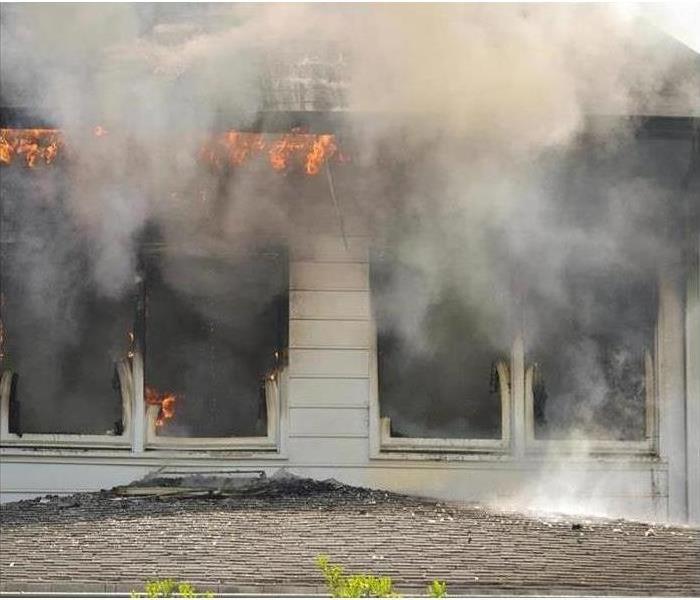 Home being damaged by fire and smoke
Home being damaged by fire and smoke
Smoke and Soot Damage Can Cause a Pervasive Odor in Your Home.
Fire can cause extensive damage to your property and belongings, but the aftermath of smoke and soot can be equally devastating. Smoke and soot can leave behind harmful residues, stains, odors, and health hazards that require professional attention. That's why you need SERVPRO® of Utah County and Downtown Salt Lake, the experts in fire restoration and smoke damage cleanup.
Smoke and Soot Facts
Smoke and soot are not uniform substances. There are two main types of smoke–wet and dry. As a result, there are different types of soot residue after a fire. Before restoration begins, SERVPRO® of Utah County and Downtown Salt Lake will test the soot to determine which type of smoke damage occurred. The cleaning procedures will then be based on the information identified during pretesting. Here are the different types of smoke:
- Wet Smoke – Plastic and Rubber
- Dry Smoke – Paper and Wood
- Protein Fire Residue – Produced by evaporation of material rather than from a fire
Our Fire Damage Restoration Services
SERVPRO® of Utah County and Downtown Salt Lake is your trusted partner in fire restoration and smoke damage cleanup. We have the training, equipment, and experience to handle any size and type of fire damage. We offer a range of services to restore your property to its preloss condition, including:
- Emergency board-up and roof tarp service to secure your property and prevent further damage
- Structural cleaning and deodorization to remove soot, stains, and odors from walls, ceilings, floors, and other surfaces
- Content cleaning and restoration to salvage and restore your belongings, such as furniture, clothing, electronics, and documents
- Pack-out and storage of salvageable items to protect them from further damage and facilitate the cleaning process
- Smoke odor removal and air purification to eliminate the unpleasant and harmful smells and particles from the air
- Carpet and upholstery cleaning to remove dirt, stains, and odors from your fabrics and textiles
- Ozone treatment and thermal fogging to neutralize and remove stubborn odors that cannot be removed by conventional methods
- Reconstruction and repair to fix any structural damage caused by the fire
Have Questions about Fire, Smoke, or Soot Damage?
Call Us Today – (801) 785-8505
SERVPRO® Utah County and Downtown Salt Lake is locally owned and operated, and we are proud to serve our community. We are available 24/7 to respond to any fire, smoke, or soot damage emergency. No matter what the cause or extent of the damage, we can make it "Like it never even happened™."
What to do after a Fire.
12/1/2023 (Permalink)
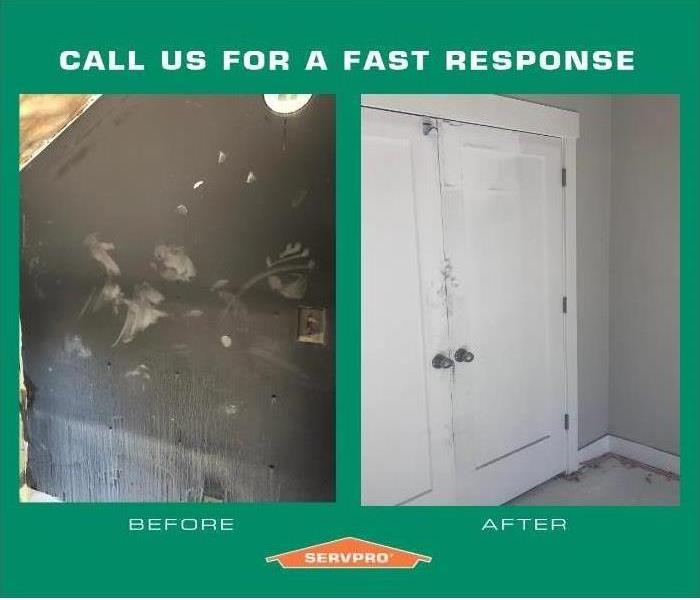 We can make it "Like it never even happened." .
We can make it "Like it never even happened." .
A fire can be very traumatic, even when you haven’t suffered injuries. Seeing the place you have worked so hard for with damages, is traumatic and devastating enough.
Renovating your house after fire damage is an essential task. The fire could have damaged the foundations and other vital parts of the house’s structure and released numerous substances from the different burned materials that can be toxic and dangerous when exposed to them, such as heavy metals, methane, sulfur dioxide, and carbon monoxide.
The quicker you take care of the damage, the fewer consequences there will be, and the more natural the restoration process can be. We have collected five steps you can follow to make the restoration process less complicated to overcome.
Step 1: Get an Assessment
Step 2: Call your insurance company
Step 3: Take Care of the structure first
Step 4: take care of Electrical System
Step 5: Cleaning & Remediation
Rebuilding Safety: 7 Easy Steps to Restore Your Home with SERVPRO
11/16/2023 (Permalink)
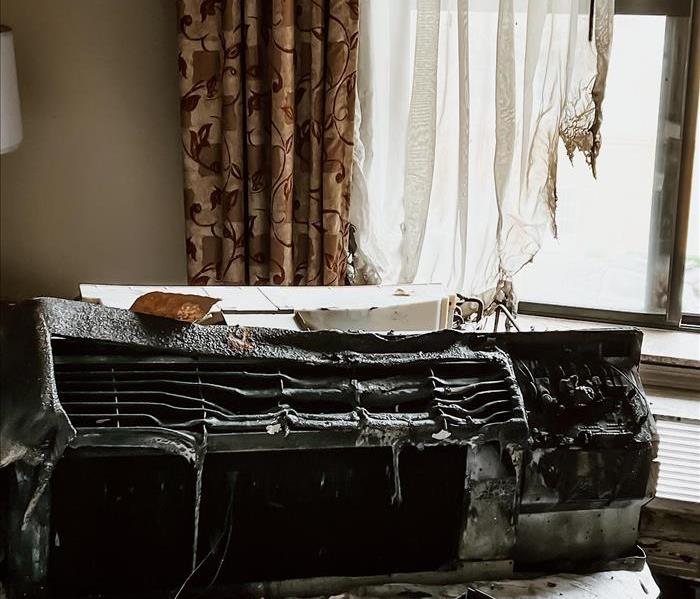 SERVPRO also offers a service at our facility where we can ozone specific items like clothing, furniture, or anything that has smoke damage and get it
SERVPRO also offers a service at our facility where we can ozone specific items like clothing, furniture, or anything that has smoke damage and get it
Every fire damage event is a little different, and requires a unique solution, but the general process stays the same. The steps listed below illustrate our process for the “typical” fire damage emergency.
Step 1: Emergency Contact
The restoration process begins when you call us. Our representative will ask questions regarding the fire damage event that will help us respond immediately with the appropriate equipment and resources.
Step 2: Inspection and Fire Damage Assessment
We carefully inspect and test adjoining rooms of your property to determine the extent of the fire, smoke, and soot damage. This step is crucial to developing a plan of action.
Step 3: Immediate Board-Up and Roof-Tarp Service
Fire damage can often compromise windows, walls, and roofs. To maintain security and to protect against further damage, we can board up missing windows and walls and place tarps on damaged roofs.
Step 4: Water Removal and Drying (if water damage is present)
The water removal process begins almost immediately and removes the majority of the water. We then use dehumidifiers and air movers to remove the remaining water and complete the drying process.
Step 5: Removal of Smoke and Soot from All Surfaces
We use specialized equipment and techniques to remove smoke and soot from ceilings, walls, and other surfaces.
Step 6: Cleaning and Sanitizing
We clean, sanitize, and disinfect all of the restorable items and structures that were damaged by the fire. We use a variety of cleaning techniques to restore your belongings to pre-fire condition. We’re also trained to remove odors using industrial air scrubbers and fogging equipment.
Step 7: Restoration
Restoration is the final step—getting your home or business to its pre-fire condition. Restoration may involve minor repairs, such as replacing drywall, painting, and installing new carpet; or it may entail major repairs such as the reconstruction of various areas or rooms in a home or business
How to Clean Black Soot from Walls
8/7/2023 (Permalink)
Whether a fire causes your home or business to be covered in black soot, a cooking accident in your kitchen leaves you with severe soot damage, or a rogue candle goes haywire, your walls require upkeep and maintenance to ensure they are successfully cleaned after damage. But what are the steps for cleaning black soot from walls?
Soot is defined as “a black substance formed by combustion or separated from fuel during combustion, rising in fine particles, and adhering to the sides of the chimney or pipe conveying the smoke.” In other words, soot is the product of incomplete combustion; since it’s a sticky substance, it tends to adhere to the location where this incomplete combustion occurred. There are a variety of sources that can contribute to soot appearing on your walls, including but not limited to:
Candles.
Fireplaces.
Exhaust from a car in a garage, which is adjacent to the affected wall.
Space heaters.
Dust, dirt, and cooking oils.
External factors such as smoke from a nearby factory.
Inhaling soot can cause health effects, which is why it’s important to contact a cleanup and restoration company like SERVPRO of Utah County as soon as you find any in your living space or business. Not only can it disrupt your daily home or business activities, but it can prove a safety hazard as well.
Tips to Clean Your Walls
- Ventilate the area to remove excess soot and odor.
- Wear household dish gloves, long-sleeved shirts, and long pants to avoid direct soot or ash contact with skin. If contact occurs, wash off soon as possible.
- Wear a dust mask such as an N-95.
- Use a dehumidifier to control moisture in the air.
- Use a dry chemical sponge to remove as much as soot as you can. This will help prevent soot from embedding deeper into the wall, where it can show up as a permanent stain.
- Follow with a low-alkali detergent, then rinse.
If all fails , you know who to call . When SERVPRO of Utah County goes out rest assure that SERVPRO of Utah County will get the job done. If water damage is present, SERVPRO of Utah County professionals will implement a water damage restoration process, using dehumidifiers, air movers, and other equipment as needed.
Upon arrival, SERVPRO of Utah County technicians will perform a walk-through of the affected area, including inspection and testing of adjoining rooms to the damage. This is a critical step, as it will help determine the best course of action to remediate your soot and other fire damage.
Space Heater Safety in Your Saratoga Springs Home
1/13/2023 (Permalink)
Anyone who has paid the bill to heat their home in the winter knows the woes and expenses associated with staying warm. In return, this is why so many people turn to their trusty space heater but is your space heater “trusty”? Did you know upwards of 25,000 house fires and 300 deaths are attributed to space heaters each year? Follow these tips to keep warm and most importantly protect your family and home this winter.
- NEVER leave a space heater unattended. Turn it off when you are leaving a room or going to sleep
- Proper placement of your space heater is crucial! Keep space heaters at least three feet away from anything that is flammable or can burn. This includes curtains, bedding, clothes, papers, etc.
- Select the appropriate space heater for the size of your room. If you are placing the heater in a bedroom or smaller area you only need a heater rated for your space. On the other hand, if you are heating a large area don’t expect to buy a smaller rated heater to heat the entire space. That leads to overuse and can cause the smaller heater to malfunction.
- Keep children and pets away from the space heater. This may sound obvious but many fires are caused by the heater getting covered or tipped into something flammable.
- Place your heater on a hard, flat surface. Most heaters have an auto-shutoff trigger on the bottom but it's better to be safe than sorry.
- As a rule of thumb plug directly into an outlet. Do not use an extension cord or power strip, which could overheat and result in a fire.
- Keep space heaters away from water. Refrain from running a space heater in a bathroom or humid room unless you have a bathroom safe model (which will be specified on the box at time of purchase)
Use common sense and be careful so you don’t become one of the 25,000 fires yearly caused by a space heater.
If you do experience a fire or anything else call SERVPRO of Utah County. As Fire and Water Damage Specialists, we have the experience, expertise, and advanced training that enables us to get your property restored quickly and thoroughly.
Commercial Fire Board Up
12/23/2022 (Permalink)
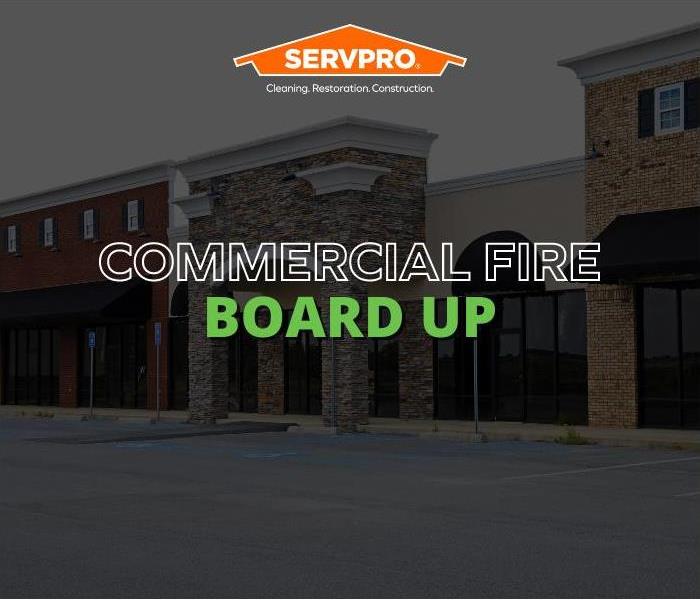 Has your commercial property experienced a fire? Call the experts at SERVPRO of Utah County for Board Up.
Has your commercial property experienced a fire? Call the experts at SERVPRO of Utah County for Board Up.
If your commercial property in Utah county has experienced a fire, there are several reasons why you might want to board up structural damage or windows. In addition to keeping the external elements out of your home with fire damage, boarding up can also prevent additional losses due to looting and make the fire cleanup process easier.
Most full-service restoration specialists offer boarding-up services. Here are four reasons to board-up after a fire.
- The premises still have sustainable inventory. If the building still contains products that appear viable, you should consider boarding. These products may involve evaluation and cleaning and may not be suitable for sale, but it may be useful for insurance reasons to have them correctly processed rather than stolen.
- You want electronics and other valuables to be protected. You may be able to restore certain electronics or other precious assets to working condition depending on the extent of the fire damage. Loss can be much more costly than repairing or replacing covered.
- You need to keep out the elements. If the structure of your property has sustained extensive damage, you should try to keep the elements out. Exposure to additional water, wind, or sunlight can compound the damage caused by smoke residue and soot.
- You want to limit soot damage. It is generally a good idea to reduce foot traffic on the scene of a recent fire. When soot gets embedded into carpeting or upholstery, it can be much more difficult to restore these materials to a pre-fire condition.
Talk to restoration experts at SERVPRO of Utah County, about whether boarding up is a good strategy for preventing loss and limiting damage after a fire. Your major concern is likely to be how to recover from fire damage as quickly and completely as possible. Preventing looting and exposure to the elements can make fire cleanup more successful.
Christmas Tree Safety
11/23/2022 (Permalink)
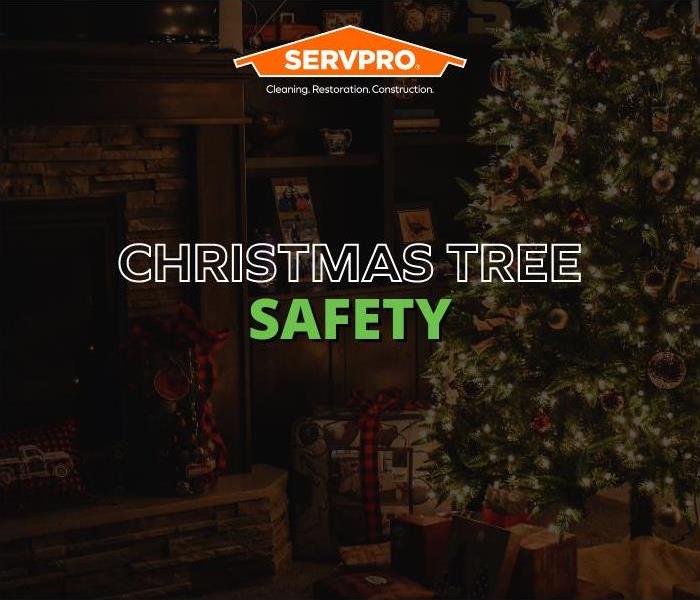 SERVPRO can help if you find yourself in this type of disaster.
SERVPRO can help if you find yourself in this type of disaster.
7 tips for preventing a Christmas tree-related fire
- Pick a fresh tree
- Keep the tree watered
- Keep the tree away from heat
- Shake the tree
- Check the tree lights
- Turn tree off when you’re not home
- Get rid of your tree soon after the holidays
Winter holiday fire facts
- Between 2013-2017, U.S. fire departments responded to an average of 160 home fires that started with Christmas trees yearly. These fires caused an average of three deaths, 15 injuries, and $10 million in direct property damage annually.
- On average, one of every 52 reported home fires that began with a Christmas tree resulted in a death, compared to an average of one death per 135 total reported home fires.
- In 44% of home Christmas tree fires, electrical distribution or lighting equipment was involved.
- In one-quarter (25%) of the Christmas tree fires, some type of heat sources, such as a candle or equipment, was too close to the tree.
- One-fifth (21%) of Christmas tree fires were intentional.
- Roughly three-quarters of Christmas tree fires occurred in December or January.
- Two of every five (39%) home Christmas tree fires started in the living room.
SERVPRO can help if you find yourself in this type of disaster.
Halloween is Coming Up Fast
9/19/2022 (Permalink)
Halloween is coming up fast. You’ve heard plenty of urban legends about safety on this night, whether it’s for you or your family. But one factor that might often be overlooked is fire safety. Using fire adds another dimension to your decorations, but as always, you want to be sure it doesn’t get out of control.
- Decorations for special events, most often involving candles, account for an annual average of 800 home fires, causing nearly $4 million in direct property damage, according to NFPA. Additionally, in the United States, more than 100 people die each year as a result of their clothing becoming ignited.
- Purchase only those costumes, wigs and props labeled as flame resistant or retardant. When creating a costume, plan carefully to ensure that it won’t easily ignite if it comes in contact with heat or flame. Costumes should be made without billowing or long trailing features that present a higher risk of ignition. Avoid highly flammable fabrics and accessories.
- Dried flowers, cornstalks and crepe paper catch fire easily. Keep all decorations away from open flames and other heat sources like light bulbs and heaters.
- Remember to keep exits clear of decorations, so nothing blocks escape routes. Make sure all smoke alarms in the home are working
- Tell children to stay away from open flames including jack-o-lanterns with candles in them. Be sure they know how to stop, drop and roll if their clothing catches fire. (Have them practice, stopping immediately, dropping to the ground, covering their face with hands, and rolling over and over to put the flames out.)
- Whenever a fire happens, it’s best to know how to escape it. Any escape routes near your house or in your neighborhood work. Don’t overcrowd your yard in case anyone needs to run away quickly enough.
- Decorations are the first thing to ignite in 900 reported home fires each year. Two of every five of these fires were started by a candle.
SERVPRO wants you to stay safe this Halloween. If you would like to know more information on fire safety please check out the National Fire protection. If you find your home with smoke damage or fire damage please call SERVPRO of Utah County we are here to help you.
Fire and Smoke Damage Do's and Don'ts
8/2/2022 (Permalink)
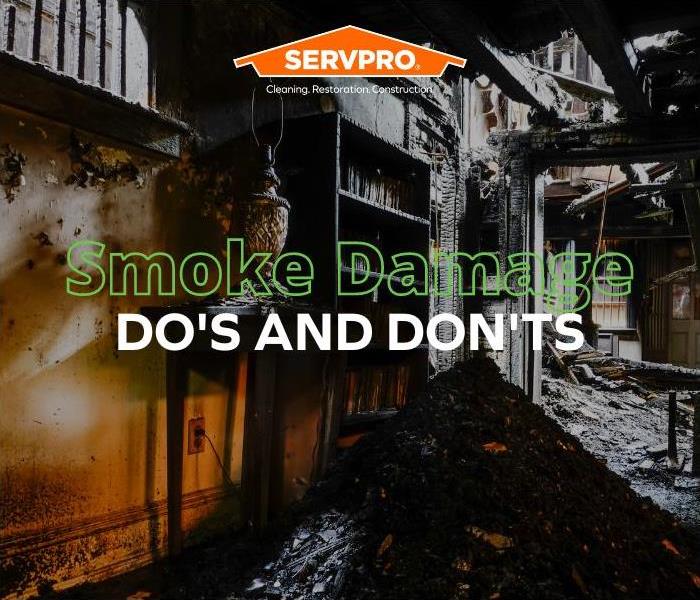 Call in the professionals at SERVPRO of Utah County. Our main office number is (801) 785-5228.
Call in the professionals at SERVPRO of Utah County. Our main office number is (801) 785-5228.
While fire damage restoration is better left in the hands of professionals, there are some things you can do on your own. Take note, however, that DIY fire restoration is something you want to do only when the severity of the fire and smoke damage is small.
Fire damage can be a devastating experience both for home and business owners. Fire damage is difficult to overcome and repair, but there are simple things you can do to motivate the process. When you’re wondering what to do after a fire, here’s a look at things to do (and things not to do) during the fire restoration process.
DOS FOR FIRE DAMAGE RESTORATION
Your checklist for after a fire should contain certain non-negotiable tasks, including:
- DO contact a certified restoration specialist: Make sure you immediately contact a certified fire and smoke restoration professional for remediation services.
- DO turn off utilities: Turn of water, electricity, gas, and any other utilities until a professional can evaluate if any of these systems were damaged during the fire.
- DO break out the vacuum: A professional should provide service, but you can enhance the professional’s chances of success by doing the first pass on your own. Use a vacuum with a brush attachment and go over your upholstered furniture. Your furniture will look better as soon as the soot is removed. Also, cover your furniture with a sheet if you need to sit on it while waiting for professional help. This will prevent the soot and ash from grinding into your upholstery.
- DO address your carpets, floors, and countertops: Give similar treatment to your carpets. Vacuum them for an immediate and superficial improvement over the damaged state. It will help prevent soot from grinding deeper into the carpet’s roots. Countertops and hardwood floors should be wiped clean to prevent the soot from deeply staining and clinging to the surfaces.
- DO check your appliances: Your utilities should be off. Make sure to empty your freezer and refrigerator, and leave the doors open to prevent mold and mildew. Likewise, winterize your plumbing and drain your hot water heater and boiler. In the absence of heat during the fire damage restoration process, fluids can freeze and cause burst pipes and other damage.
- DO take care of pets: Remove pets from your fire-damaged home. Lingering soot and smoke can be harmful to them.
DON’TS FOR FIRE DAMAGE RESTORATION
Your checklist should also include several things to avoid at all times, including:
- DON’T use your AC, heater or electronics: Wait until a professional arrives on the scene — same with electronics like the television, computers and DVD players. Turning on electronics can create greater damage.
- DON’T clean walls or clothing: Also, do not clean walls, ceilings and other similar surfaces, and wait to clean your clothing and similar garments. A professional should examine them first and provide advice.
- DON’T eat leftover food: Never eat anything that was in the home during the fire. It is most likely not safe to consume due to contamination from smoke, soot, or contaminants introduced to the environment when the fire was being extinguished.
- DON’T wipe away powder from extinguishers: Forgo trying to clean up any staining from the powder discharged by a fire extinguisher. It is best to let professionals guide the cleanup of these areas.
ALWAYS CALL AN EXPERT
If you’re wondering what to do after a fire, it’s always tempting to start the cleanup process immediately, and do as much as possible. The best course of action is to hire a certified professional, like those at SERVPRO of Utah County, to provide expert knowledge and service. The situation requires specialized tools and knowledge that only a professional can provide. A trusted professional will offer an after-fire checklist that will help speed along the fire and smoke damage cleanup process. Consulting a professional will help you restore your property back to like-new condition as quickly as possible.
How Do Restoration Companies Cleanup After Fire Damage to a American Fork Home?
6/27/2022 (Permalink)
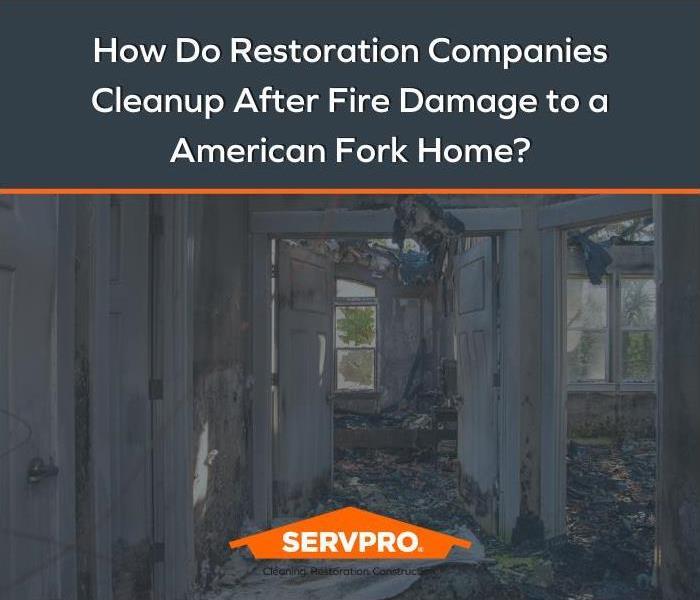 Many methods are used when restoring a home after a fire. Contact SERVPRO right away and let our expertise work for you.
Many methods are used when restoring a home after a fire. Contact SERVPRO right away and let our expertise work for you.
Fire can wreak havoc on your American Fork home. The smoke and soot can cause irreparable damage if it is not taken care of promptly and efficiently. Successful cleanup and restoration after a fire is a job for professionals. Trying to get the damage repaired or restored by yourself can worsen the already bad situation.
SERVPRO professionals have years of experience in successful restoration and cleanup of hundreds of homes after fire damage here in American Fork. Our meticulous technicians use tested scientific methods to get rid of the damage due to fire. Our state-of-the-art, multi-step cleaning process restores your home back to the pre-damage condition in no time. Here are the four scientific principles that enable SERVPRO of Utah County technicians to restore your home after a fire damage.
Modulating the temperature can hasten the cleaning process
Smoke and soot can build up on the walls and ceilings after an incidence of fire. These residues are notoriously difficult to clean even with some of the best and most active cleaning agents. SERVPRO technicians use their knowledge of chemistry to handle such stains. We use an elevated temperature that speeds up the reaction between cleaning agents and the stain causing residues.
Agitation can speed up cleaning process
SERVPRO technicians use various agitation techniques such as brushing, air, and water pressure and even sound waves at high frequencies to clean difficult to clean stains. Our technicians have a thorough understanding of how the process of agitation works and how it can be successfully implemented depending on the nature of the damage.
Chemical cleaning products can work wonders
Various chemical cleaning products can work wonders cleaning the smoke and soot residue if they are carefully selected depending on the type of the damage. Our expert technicians use their extensive experience and knowledge to choose the best possible chemical cleansing agents that can clean the damage in no time.
Restoring fire damage is a process that involves careful planning and expertise. You can trust us to ensure that your home looks, smells and feels like home again in no time.
Smoke Damage in your Saratoga Springs Business?
6/20/2022 (Permalink)
You can count on SERVPRO® of Saratoga Springs to respond quickly and immediately begin the cleanup and restoration process when fire damage happens. The fuels burned in a fire leave different residue signatures in the smoke and soot. We test the soot to determine which type of smoke damage occurred.
Smoke and soot facts:
- Hot smoke migrates to cooler areas and upper levels of a structure
- Smoke flows around plumbing systems, seeping through the holes used by pipes to go from floor to floor
- The type of smoke may significantly affect the restoration process
Cleaning Methods
- Dry Cleaning - used for cleaning light residues or to pre-clean before wet cleaning
- Wet Cleaning -an effective cleaning method for removing moderate to heavy residues
- Spray and Wipe - effective for items that can’t withstand wet cleaning
- Foam Cleaning - used for upholstery fabrics that might shrink or bleed if wet cleaned
- Abrasive Cleaning - involves agitation of the surface being cleaned
- Immersion Cleaning - contents are dipped into a bath of the cleaning product
Call Us!
Saratoga Springs businesses rely on SERVPRO® of Saratoga Springs to respond to fire damage emergencies 24-hours a day. Our team of highly trained technicians are on-call and ready to serve you every day of the year. Call us today at (801) 785-5228.
What to expect after a home fire!
4/21/2022 (Permalink)
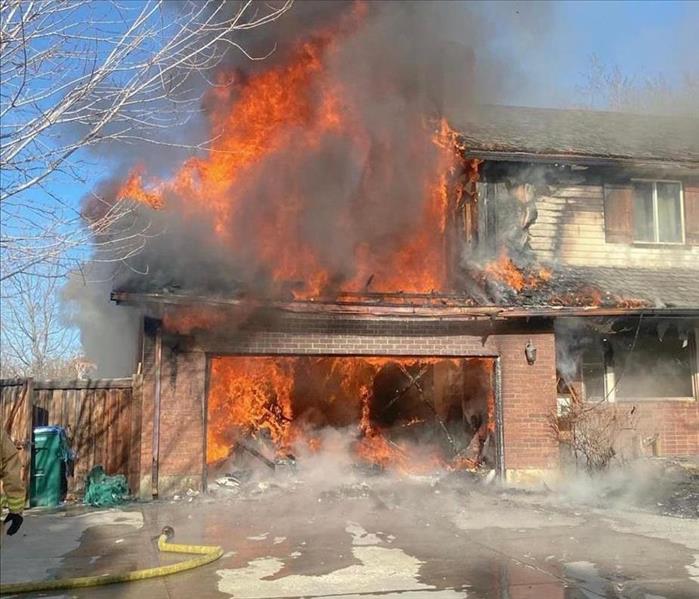 Being prepared and knowing what to expect after a home will be extremely helpful in case you find yourself in this disaster.
Being prepared and knowing what to expect after a home will be extremely helpful in case you find yourself in this disaster.
After any fire damage situation, your primary focus should be safety:
- Is it safe to stay in the house?
- Electrical and "slip and fall" hazards are some of the most prevalent concerns.
- Only do activities that are safe for you to perform.
- Wet materials can be VERY heavy. Be careful!
What To Do After A Fire
- Limit movement in the home to prevent soot particles from being embedded into upholstery and carpets.
- Keep hands clean so as not to further soil upholstery, walls and woodwork.
- Place clean towels or old linens on rugs, upholstery and carpet traffic areas.
- If electricity is off, empty freezer and refrigerator and prop doors open.
- Clean and protect chrome with light coating of petroleum jelly or oil.
- Wash houseplants on both sides of leaves.
- Change HVAC filter.
- Tape double layers of cheesecloth over air registers.
What NOT To Do After A Fire
- Don't attempt to wash any walls or painted surfaces or shampoo carpet or upholstery without contacting your SERVPRO Franchise Professional.
- Don't attempt to clean any electrical appliances that may have been close to fire, heat, or water without consulting an authorized repair service.
- Don't use any canned or packaged food or beverages that may have been stored near the fire, heat, or water.
- Don't turn on ceiling fixtures if the ceiling is wet. The wiring may be damaged.
- Don't send garments to an ordinary dry cleaner. Improper cleaning may set smoke odor.
9 Home Fire Tips That Will Alarm You
1/13/2022 (Permalink)
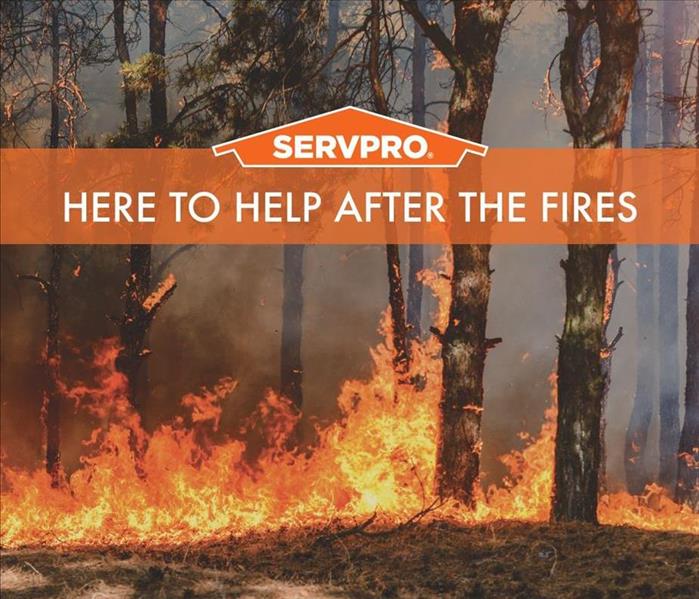 Fires can really be so devastating. Here at SERVPRO we really are here to help ease that stress.
Fires can really be so devastating. Here at SERVPRO we really are here to help ease that stress.
Home Fires
Home fires happen and so many of them can be prevented. This happens to over 350,000 homes each year. By knowing some of these home safety tips you can lower the risk and help protect your loved ones.
- People are twice as likely to die in a fire where there aren’t working smoke alarms. Make sure you have working smoke alarms.
- You need a smoke alarm in the basement and attic but not your bathroom or kitchen. Those get set off too easy and you tend to take the battery out. Therefore you now won’t be notified of smoke. There should be one in each bedroom, one outside each sleeping area, one in each hallway, and one on every level of your home.
- Smoke alarms do have expiration dates. Make sure you’re changing them every 10 years.
- You may only have 2 min to get out of your home when there is a fire. Once to smolder happens on a curtain or couch, it can reach a flashpoint within two minutes. Most furniture is made of synthetic material in today's world and that burns a lot faster.
- Make sure you have a meeting place for if a fire happens.
- Failure to clean your dryer can cause a fire.
- Maintain your furnace. This is one a lot of people don’t know about. Servicing your furnace biannually is a wonderful idea.
- Cooking is still the leading cause of home fires. Stay in the kitchen while cooking.
- A quarter of fires happen when people are sleeping. Try not to cook while sleeping.
I hope these tips can help you keep your home a little safer. If you do have a fire, we are happy to help you here at SERVPRO with what is next and take some of that burden off of you.
Home Fire? Here is our process to help you.
12/13/2021 (Permalink)
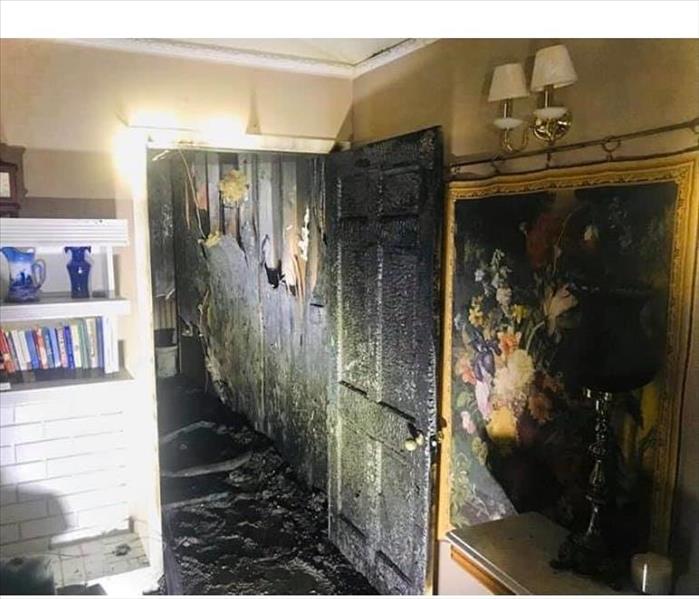 These fires can be devastating. Let SERVPRO help you and take that stress away.
These fires can be devastating. Let SERVPRO help you and take that stress away.
After the fire trucks leave, your home likely suffers from fire and smoke damage and extensive water damage from firefighting efforts. SERVPRO Franchise Professionals have the specialized fire restoration training needed to restore your home to pre-fire condition.
Every fire damage event is a little different and requires a unique solution, but the general process stays the same. The steps listed below illustrate our process for the “typical” fire damage emergency.
Step 1: Emergency Contact
The restoration process begins when you call the SERVPRO National Call Center, which is staffed 24 hours a day. Our representative will ask a series of questions regarding the fire damage event that will help us dispatch the nearest SERVPRO Franchise Professional with the appropriate equipment and resources.
Step 2: Inspection and Fire Damage Assessment
Our Professionals will carefully inspect and test adjoining rooms of your property to determine the extent of the fire, smoke, and soot damage. This step is crucial to developing a plan of action.
Step 3: Immediate Board-Up and Roof-Tarp Service
Fire damage can often compromise windows, walls, and roofs. To maintain security and to protect against further damage, the SERVPRO Franchise Professional can board up missing windows and walls and place tarps on damaged roofs.
Step 4: Water Removal and Drying (if water damage is present)
The water removal process begins almost immediately and removes the majority of the water. They will then use dehumidifiers and air movers to remove the remaining water and complete the drying process.
Step 5: Removal of Smoke and Soot from All Surfaces
The SERVPRO Franchise Professionals use specialized equipment and techniques to remove smoke and soot from ceilings, walls, and other surfaces.
Step 6: Cleaning and Sanitizing
They will clean all of the restorable items and structures that were damaged by the fire. They use a variety of cleaning techniques to restore your belongings to pre-fire condition. They’re also trained to remove odors using industrial air scrubbers and fogging equipment.
Step 7: Restoration
Restoration is the final step—getting your home or business to its pre-fire condition. Restoration may involve minor repairs, such as replacing drywall, painting, and installing new carpet; or it may entail major repairs such as the reconstruction of various areas or rooms in a home or business.
Frying a turkey this Thanksgiving? Here are some tips.
11/24/2021 (Permalink)
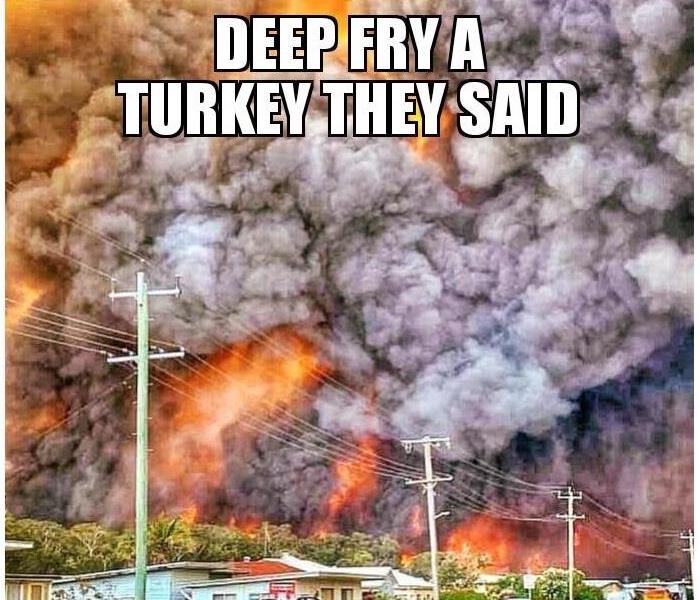 Call SERVPRO today if you happen to have a mishap with the turkey.
Call SERVPRO today if you happen to have a mishap with the turkey.
In 2018, U.S. fire departments responded to an estimated 1,630 home cooking fires on Thanksgiving, the peak day for such fires. Unattended cooking was by far the leading contributing factor in cooking fires and fire deaths.
Have a fire extinguisher nearby. Make sure your vessel is large enough to fit the oil and the turkey. Avoid deep-frying a turkey with stuffing inside.
How do you put out a turkey fire? - Use well-insulated potholders or oven mitts when touching pot or lid handles.
- Wear safety goggles to protect your eyes from oil splatter.
- Use a fire extinguisher to put out the fire.
- Do NOT use water to put out the fire (oil + water do not mix!)
Fire Escape plan
9/30/2021 (Permalink)
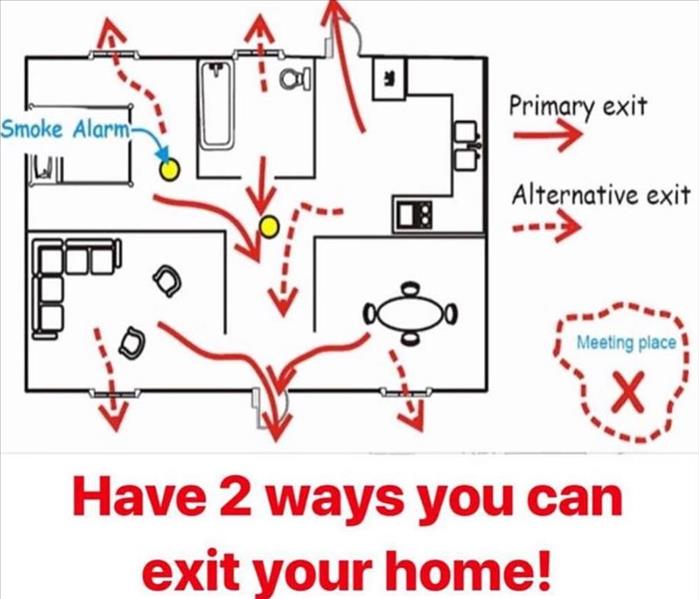 Make a fire escape plan with your family!!
Make a fire escape plan with your family!!
In 2016 there were an estimated 364,300 reported residential fires and 2,000 fire-related fatalities. In the event of a fire, TIME is the BIGGEST ENEMY and EVERY SECOND COUNTS! In less than 30 seconds a small flame can turn into a major fire. The most important thing you can do to prepare is to have a Safety Escape Plan.
At Home Fire Safety Plan Tips
First and foremost, make sure you have one working smoke alarm on every level of the home, as well as inside and outside each sleeping area.
Have two ways out of each room, and the proper equipment to get out any upper story windows. Walkthrough each room in your home with your family and point out possible exits. Also, provide alternatives for anyone with a disability.
Once you have established the exits, practice and show children how to get out of the house and check the door for heat before opening it.
Know to crawl low to the floor when escaping to avoid toxic smoke. Practice dropping to your stomach and shimmying out under the smoke with your children.
Make a plan to help pets evacuate safely as well if possible.
Once you are out of the house, STAY OUT. DO NOT go back in the house. There could be unseen damage and danger. Call 911 immediately.
Know where to meet after the escape. Your meeting place should be near the front of your home so firefighters know you are out.
Practice, Practice, Practice your escape plan. It is recommended you practice at least twice a year. If you have young children it may require more than twice. Practicing can save the lives of you and your family.
If you do have a fire in your home call SERVPRO Utah County 801-785-5228
Why board up after a fire?
8/3/2021 (Permalink)
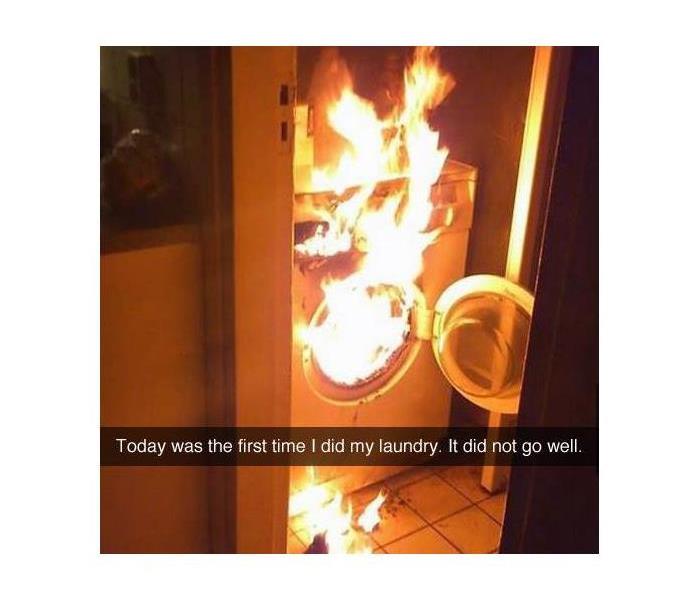 We hope these few tips can help.
We hope these few tips can help.
If your Commercial property in Utah county has experienced a fire, there are several reasons why you might want to board up structural damage or windows. In addition to keeping the external elements out of your home with fire damage, boarding up can also prevent additional losses due to looting and make the fire cleanup process easier.
Boarding Up
Most full-service restoration specialists offer boarding-up services. Here are four reasons to board-up after a fire.
1. The premises still have sustainable inventory. If the building still contains products that appear viable, you should consider boarding. These products may involve evaluation and cleaning and may not be suitable for sale, but it may be useful for insurance reasons to have them correctly processed rather than stolen.
2. You want electronics and other valuables to be protected. You may be able to restore certain electronics or other precious assets to working condition depending on the extent of the fire damage. Loss can be much more costly than repairing or replacing covered.
3. You need to keep out the elements. If the structure of your property has sustained extensive damage, you should try to keep the elements out. Exposure to additional water, wind, or sunlight can compound the damage caused by smoke residue and soot.
4. You want to limit soot damage. It is generally a good idea to reduce foot traffic on the scene of a recent fire. When soot gets embedded into carpeting or upholstery, it can be much more difficult to restore these materials to a pre-fire condition.
Talk to restoration experts at SERVPRO of Utah County, about whether boarding-up is a good strategy for preventing loss and limiting the damage after a fire. Your major concern is likely to be how to recover from fire damage as quickly and completely as possible. Preventing looting and exposure to the elements can make fire cleanup more successful.
Water and worn cords can cause fire damage to your Lehi home.
6/28/2021 (Permalink)
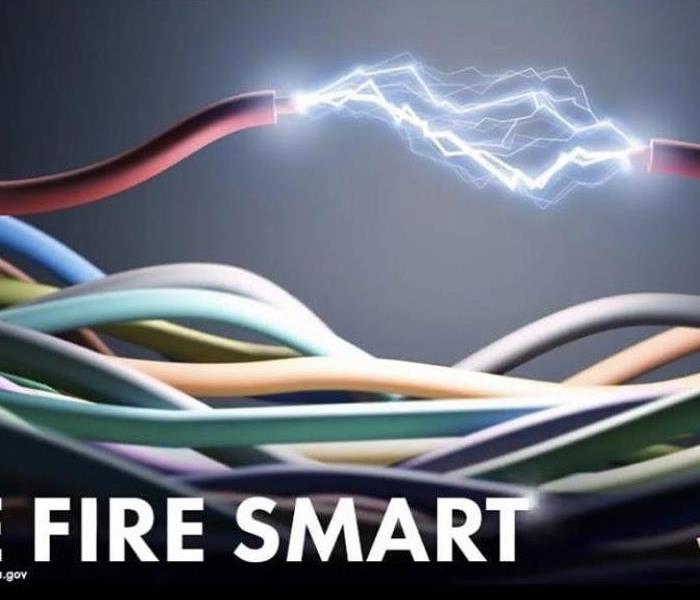 Maintain the appliances in your home to help prevent a fire. Should you have a fire, call SERVPRO.
Maintain the appliances in your home to help prevent a fire. Should you have a fire, call SERVPRO.
When a water line to your refrigerator drips in your Lehi kitchen, this might seem a minor inconvenience. However, this can cause problems with dry rotting or microbial activity from the water itself, but other issues can also present themselves. Cords to heavy appliances often become nicked and crimped when someone moves them, and sometimes creating tiny breaks in the insulation.
If your refrigerator cord contains such breaks, your home can eventually become a victim to fire damage in Lehi. Electrical fires can melt the exterior of the appliance that caused the fire, as well. We can mitigate all of the damage caused by such fires and get your home wholly restored. Our employees are certified by the IICRC and understand the complexities that can result from such fires.
Electrical shocks can pose a risk when trying to put out such a fire. Always shut off the electricity at the breaker before attempting to extinguish a small fire like this. More massive fires require you to evacuate your home and call the fire department from a phone outside of your home. Staying safe in an emergency can seem difficult when valuable items tempt you to return for their removal. However, calling emergency services can save your life. We can help you restore the majority of your belongings.
Items that were located in other areas of your home can become covered in a film from the fire. When plastic composites burn, greasy soot spews out of the fire, covering everything in your home. We get to work cleaning this away from your belongings and home furnishings. Allowing it to settle allows it to cause finishes to become ruined. We clean small items at our facility after boxing them up and restore larger ones at your home. We compile inventory sheets to allow you to find anything we take away from your home. These same sheets can help you return items to their original location, as well.
SERVPRO of Utah County can restore your home after events involving fire damage, as well as other disasters. Our number, (801) 785-5228, puts you in contact with our caring professionals 24 hours a day, every day of the year.
Take these 5 steps after a home fire.
6/23/2021 (Permalink)
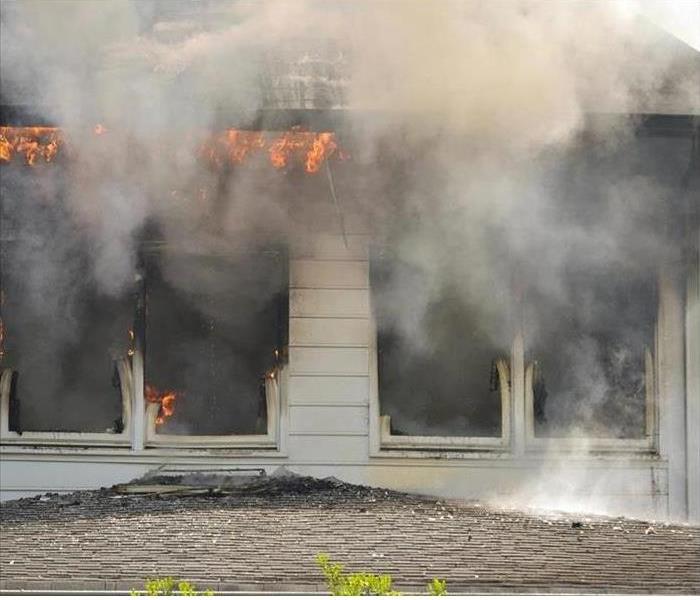 These tips can help make your disaster a little less stressful. Call SERVPRO if you need help. We are happy to help.
These tips can help make your disaster a little less stressful. Call SERVPRO if you need help. We are happy to help.
A fire can be very traumatic, even when you haven’t suffered injuries. Seeing the place you have worked so hard for with damages, is traumatic and devastating enough.
Renovating your house after fire damage is an essential task. The fire could have damaged the foundations and other vital parts of the house’s structure and released numerous substances from the different burned materials that can be toxic and dangerous when exposed to them, such as heavy metals, methane, sulfur dioxide, and carbon monoxide.
The quicker you take care of the damage, the fewer consequences there will be, and the more natural the restoration process can be. We have collected five steps you can follow to make the restoration process less complicated to overcome.
Step 1: Get an Assessment
Step 2: Call your insurance company
Step 3: Take Care of the structure first
Step 4: take care of Electrical System
Step 5: Cleaning & Remediation
Prevent Home Fires
4/28/2021 (Permalink)
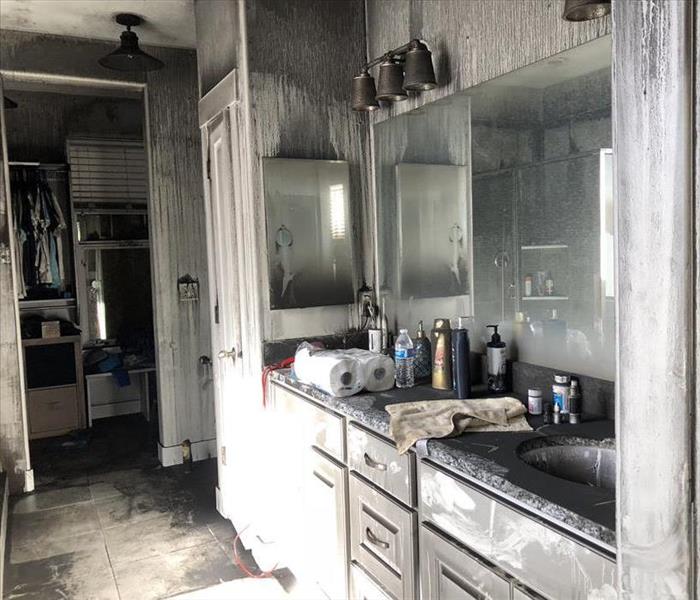 Fires are always preventable. Make sure you are taking these tips and being safe!
Fires are always preventable. Make sure you are taking these tips and being safe!
Home fires are preventable!
Cooking
- Stay in the kitchen when you are frying, grilling, or broiling food. If you leave the kitchen for even a short period of time turn off the stove.
- Wear short, close-fitting, or tightly rolled sleeves when cooking.
- Position barbecue grills at least 10 feet away from siding and deck railings, and out from under eaves and overhanging branches.
- Keep a fire extinguisher available.
Electrical and Appliance Safety
- Frayed wires can cause fires. Replace all worn, old or damaged appliance cords immediately and do not run cords under rugs or furniture.
- If an appliance has a three-prong plug, use it only in a three-slot outlet. Never force it to fit into a two-slot outlet or extension cord.
- Immediately shut off, then professionally replace, light switches that are hot to the touch and lights that flicker.
Space Heaters
- Keep combustible objects at least three feet away from portable heating devices.
- Buy only heaters evaluated by a nationally recognized laboratory, such as Underwriters Laboratories (UL).
- Check to make the portable heater has a thermostat control mechanism and will switch off automatically if the heater falls over.
- Only use crystal clear K-1 kerosene in kerosene heaters. Never overfill it. Use the heater in a well-ventilated room.
Fireplaces and Woodstoves
- Inspect and clean woodstove pipes and chimneys annually and check monthly for damage or obstructions.
- Use a fireplace screen heavy enough to stop rolling logs and big enough to cover the entire opening of the fireplace to catch flying sparks.
- Make sure the fire is completely out before leaving the house or going to bed.
More Prevention Tips
- Never use a stove range or oven to heat your home.
- Keep combustible and flammable liquids away from heat sources.
- Portable generators should NEVER be used indoors and should only be refueled outdoors and in well-ventilated areas.
After a fire: What you can do until help arrives.
2/17/2021 (Permalink)
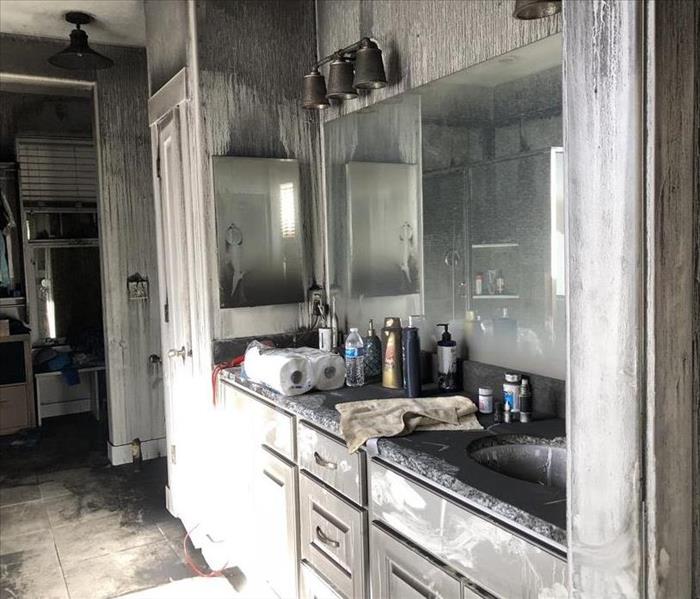 Call SERVPRO today if you find yourself in this problem!
Call SERVPRO today if you find yourself in this problem!
After any fire damage situation, your primary focus should be safety:
- Is it safe to stay in the house?
- Electrical and "slip and fall" hazards are some of the most prevalent concerns.
- Only do activities that are safe for you to perform.
- Wet materials can be VERY heavy. Be careful!
What To Do After A Fire
- Limit movement in the home to prevent soot particles from being embedded into upholstery and carpets.
- Keep hands clean so as not to further soil upholstery, walls and woodwork.
- Place clean towels or old linens on rugs, upholstery and carpet traffic areas.
- If electricity is off, empty freezer and refrigerator and prop doors open.
- Clean and protect chrome with light coating of petroleum jelly or oil.
- Wash houseplants on both sides of leaves.
- Change HVAC filter.
- Tape double layers of cheesecloth over air registers.
What NOT To Do After A Fire
- Don't attempt to wash any walls or painted surfaces or shampoo carpet or upholstery without contacting your SERVPRO Franchise Professional.
- Don't attempt to clean any electrical appliances that may have been close to fire, heat, or water without consulting an authorized repair service.
- Don't use any canned or packaged food or beverages that may have been stored near the fire, heat, or water.
- Don't turn on ceiling fixtures if the ceiling is wet. The wiring may be damaged.
- Don't send garments to an ordinary dry cleaner. Improper cleaning may set smoke odor.
Christmas tree safety!
12/21/2020 (Permalink)
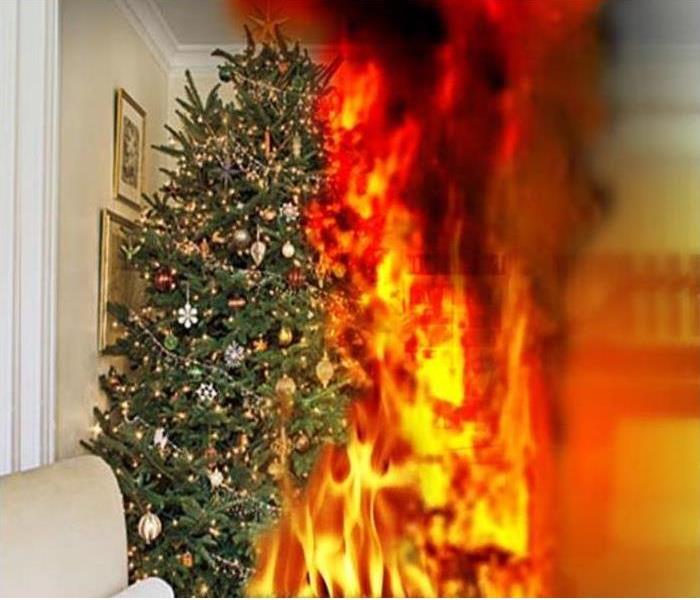 SERVPRO can help if you find yourself in this type of disaster.
SERVPRO can help if you find yourself in this type of disaster.
7 tips for preventing a Christmas tree-related fire
- Pick a fresh tree
- Keep the tree watered
- Keep the tree away from heat
- Shake the tree
- Check the tree lights
- Turn tree off when you’re not home
- Get rid of your tree soon after the holidays
Winter holiday fire facts
- Between 2013-2017, U.S. fire departments responded to an average of 160 home fires that started with Christmas trees per year. These fires caused an average of three deaths, 15 injuries, and $10 million in direct property damage annually.
- On average, one of every 52 reported home fires that began with a Christmas tree resulted in a death, compared to an average of one death per 135 total reported home fires.
- Electrical distribution or lighting equipment was involved in 44% of home Christmas tree fires.
- In one-quarter (25%) of the Christmas tree fires, some type of heat source, such as a candle or equipment, was too close to the tree.
- One-fifth (21%) of Christmas tree fires were intentional.
- Roughly three-quarters of Christmas tree fires occurred in December or January.
- Two of every five (39%) home Christmas tree fires started in the living room.
SERVPRO can help if you find yourself in this type of disaster.
Home Fire Tips!
10/19/2020 (Permalink)
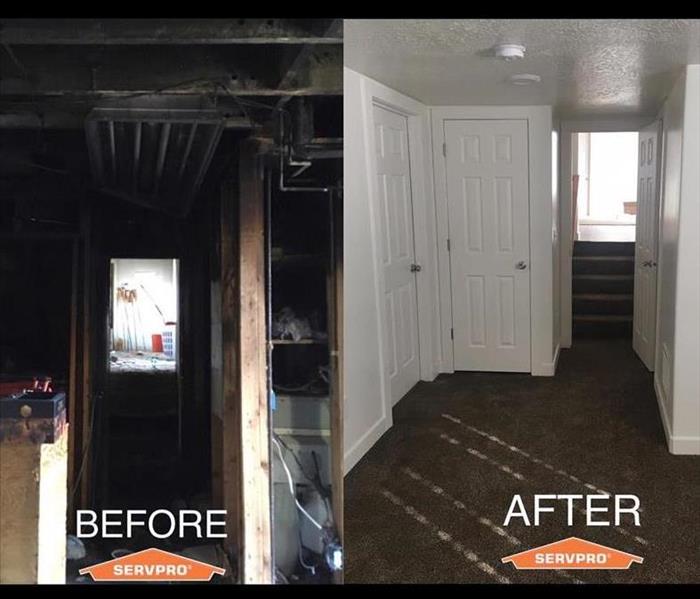 This is a before and after of a job we did from a house fire. Rememeber these tips.
This is a before and after of a job we did from a house fire. Rememeber these tips.
Each year more than 2,500 people die and 12,600 are injured in home fires in the United States. But unlike other disasters, home fires can be prevented! It’s important to know this: Fire is fast! There is no time to gather anything or make a phone call. In just two minutes, a fire could kill you. In five minutes, a house could be swallowed in flames. Fire is hot! Heat and smoke could be even more dangerous than the flames. Fire is dark! It can be hard to find your way out of your house in a fire.
BEFORE:
-Create a fire escape plan and practice it twice a year.
-Have smoke alarms in every bedroom and every floor of the house.
-Remind your parents to test the smoke alarms in your house every month.
-Find two ways to get out of each room. A window might be a second way if the door is blocked by fire or smoke.
-Practice feeling your way out of the house in the dark or with your eyes closed.
-Sleep with your door closed. It helps prevent fires from spreading quickly.
DURING:
-Get low and go! Crawl under the smoke to an exit. Heavy smoke and deadly gases collect along the ceiling.
- If you hear a smoke alarm, get out fast! You may only have a few seconds to escape.
-If smoke is blocking the door, use your second way out of the room or house.
-Feel the doorknob and door before opening it. If either is hot, leave the door closed and use the second way out. If you see smoke coming around the door, use the second way out.
-If you do open a door, open it slowly and be ready to shut it quickly if there’s smoke.
-Don’t hide from firefighters! They may look scary with all of their equipment, but they are there to help you.
- Tell firefighters if there are any pets trapped in the house. Don’t try to get them yourself!
-If your clothes catch on fire, stop-drop-roll! Stop, drop to the ground, and cover your face with your hands. Then roll over and over or back and forth until the fire is out.
AFTER:
-Don’t go back into any building unless a firefighter or your parents say it is safe.
Call SERVPRO of North Utah County to restore your home after a fire. We can make it "Like it never even happened."
What fire suppression system do you have?
8/13/2020 (Permalink)
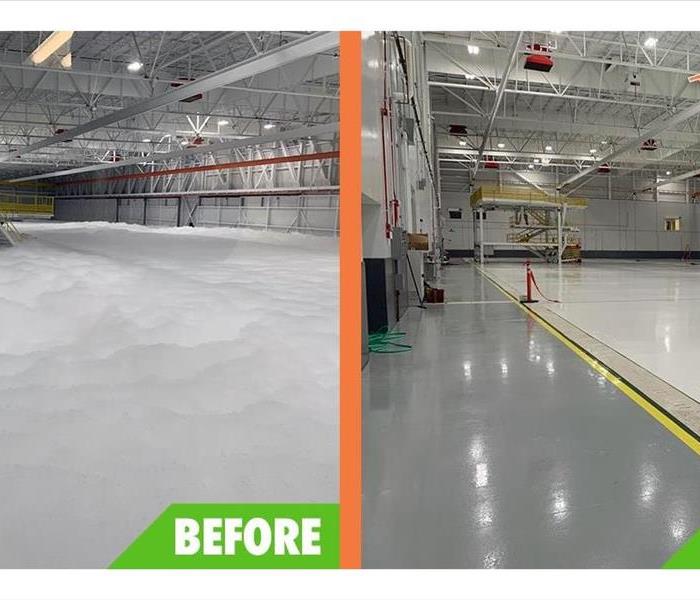 No job is to big for SERVPRO!!
No job is to big for SERVPRO!!
If you are using foam fire suppressants in your fire protection system. They are a leading company in the distribution of foam for fire protection in the world. Foam is an effective fire protectant for challenging fire hazards in industries such as the military, airports, petrochemical plants, and power plants. There are many different types of foam fire suppressant products available from high expansion to Class A foams to name a few.
High Expansion Foam
As stated above, there are several types of foam and they all have their different uses. High expansion foam is one of the types of foam used in the market today. Facilities would choose this type of foam if they need a large volume of fire protectant that can fill a space in a hurry. Facilities such as airport hangars have large open spaces that may need to be protected in a hurry so having a fire protectant that can fill that space rapidly becomes important. This type of foam is used often in the event of Class A fires and also flammable liquid fires. Normally running at a concentration of 2%, they have a high expansion foam that can be used in a variety of applications. They also have a medium and low expansion foam as well that can be used depending on the specific hazard that is being protected.
Class A Foam Concentrates
Class A foam concentrates are used in many different firefighting applications. They mix the foam with water which will help suppress Class A fires. Class A fires are fires that deal with solid materials such as wood, paper, and or textiles. Their Class A foam concentrate also has specific properties that when combined with water allow it to cling better to surfaces which minimize runoff and reduce the amount of water needed to extinguish the fire. This makes it a more environmentally friendly foam concentrate than some of the other products on the market.
Fire and smoke damage do's and don'ts
7/21/2020 (Permalink)
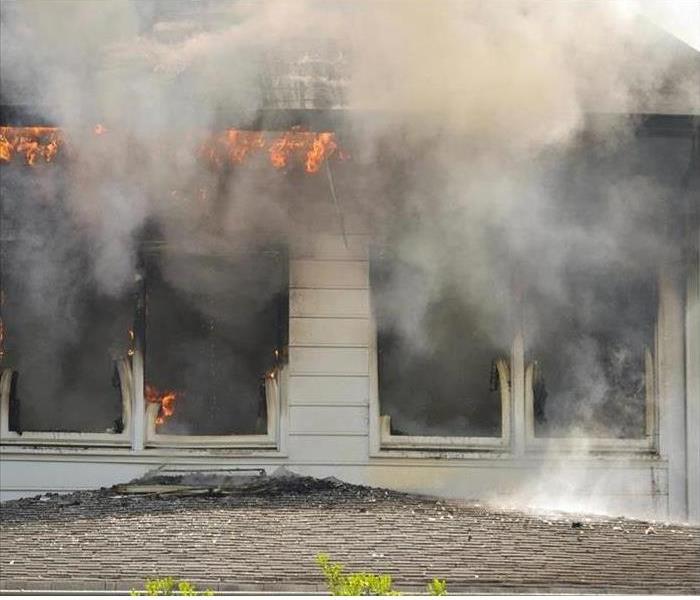 Rememeber these do's and don'ts and let SERVPRO help you.
Rememeber these do's and don'ts and let SERVPRO help you.
While fire damage restoration is better left in the hands of professionals, there are some things you can do on your own. Take note, however, that DIY fire restoration is something you want to do only when the severity of the fire and smoke damage is small.
Fire damage can be a devastating experience both for home and business owners. Fire damage is difficult to overcome and repair, but there are simple things you can do to motivate the process. When you’re wondering what to do after a fire, here’s a look at things to do (and things not to do) during the fire restoration process.
DOS FOR FIRE DAMAGE RESTORATION
Your checklist for after a fire should contain certain non-negotiable tasks, including:
- DO contact a certified restoration specialist: Make sure you immediately contact a certified fire and smoke restoration professional for remediation services
- DO turn off utilities: Turn of water, electricity, gas, and any other utilities until a professional can evaluate if any of these systems were damaged during the fire.
- DO break out the vacuum: A professional should provide service, but you can enhance the professional’s chances of success by doing the first pass on your own. Use a vacuum with a brush attachment and go over your upholstered furniture. Your furniture will look better as soon as the soot is removed. Also, cover your furniture with a sheet if you need to sit on it while waiting for professional help. This will prevent the soot and ash from grinding into your upholstery.
- DO address your carpets, floors, and countertops: Give similar treatment to your carpets. Vacuum them for an immediate and superficial improvement over the damaged state. It will help prevent soot from grinding deeper into the carpet’s roots. Countertops and hardwood floors should be wiped clean to prevent the soot from deeply staining and clinging to the surfaces.
- DO check your appliances: Your utilities should be off. Make sure to empty your freezer and refrigerator, and leave the doors open to prevent mold and mildew. Likewise, winterize your plumbing and drain your hot water heater and boiler. In the absence of heat during the fire damage restoration process, fluids can freeze and cause burst pipes and other damage.
- DO take care of pets: Remove pets from your fire-damaged home. Lingering soot and smoke can be harmful to them.
DON’TS FOR FIRE DAMAGE RESTORATION
Your checklist should also include several things to avoid at all times, including:
- DON’T use your AC, heater or electronics: Wait until a professional arrives on the scene — same with electronics like the television, computers, and DVD players. Turning on electronics can create greater damage.
- DON’T clean walls or clothing: Also, do not clean walls, ceilings, and other similar surfaces, and wait to clean your clothing and similar garments. A professional should examine them first and provide advice.
- DON’T eat leftover food: Never eat anything that was in the home during the fire. It is most likely not safe to consume due to contamination from smoke, soot, or contaminants introduced to the environment when the fire was being extinguished.
- DON’T wipe away powder from extinguishers: Forgo trying to clean up any staining from the powder discharged by a fire extinguisher. It is best to let professionals guide the cleanup of these areas.
- ALWAYS CALL AN EXPERT
- If you’re wondering what to do after a fire, it’s always tempting to start the cleanup process immediately and do as much as possible. The best course of action is to hire a certified professional to provide expert knowledge and service. The situation requires specialized tools and knowledge that only a professional can provide. A trusted professional will offer an after-fire checklist that will help speed along the fire and smoke damage cleanup process. Consulting a professional will help you restore your property back to like-new condition as quickly as possible.
Removing Smoke Odor From Home!
6/11/2020 (Permalink)
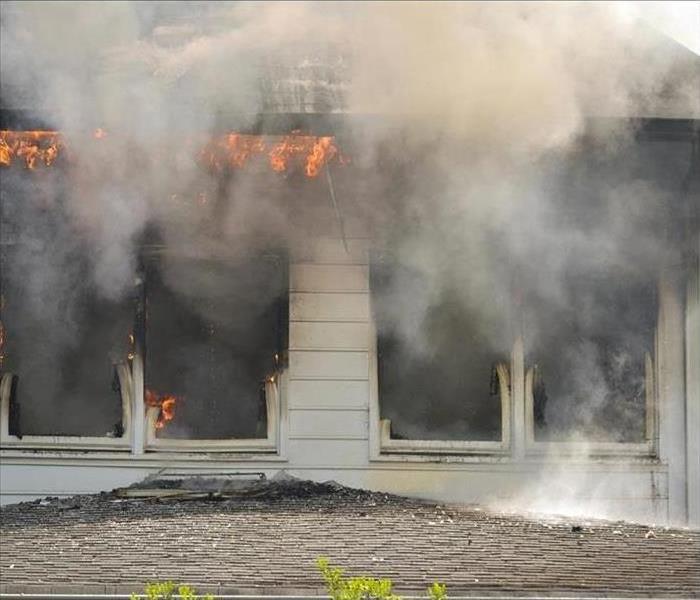 Smoke odor can be so frustrating. Let SERVPRO help.
Smoke odor can be so frustrating. Let SERVPRO help.
SMOKE ODOR – WHAT CAUSES IT?
Obviously, the smell of smoke is caused by a fire. There’s truth in the saying “where there’s smoke, there’s fire,” after all. Now, the smell of smoke could be caused by a fire in your kitchen because you forgot to turn off the stove. It could be burnt food because your partner can’t cook to save his/her life. It could be smoke from a cigar or cigarette.
It can even be from your neighbor who is nice enough to burn something right outside your open window. It doesn’t really matter what the source is (though you do need to locate the source for safety purposes, ok?) because it all comes down to one thing – the smell sticks to your house and belongings like glue. And eliminating that smell is just a small part of the problem.
Any kind of smoke that is caused by burning carbon-based materials such as wood, paper, oil, gas, or food can produce carbon monoxide. If you don’t know this yet, this is an odorless, colorless gas that can be harmful.
HOW TO ELIMINATE SMOKE ODOR IN HOUSE
When it comes to smoke odor removal, there are several options available. Some may use scented candles, air fresheners, and sprays to get rid of smoke odor or any kind of unpleasant smell.
However, they’ll soon realize that there is only so much scented candles or sprays can do for the problem. In fact, they can make matters worse, as they simply combine with the smoke smell and leave behind something quite unpleasant. Even opening your windows and letting fresh air in won’t be getting rid of the smoke odor completely.
A lot of people believe that a good scrub will be enough to get rid of the smell of smoke in a house. And they’re right in a sense. You can scrub your walls plus your ceilings with ammonia and water to get rid of the smell of smoke, especially if it was just a small amount and the room wasn’t exposed too long to the smoke. You probably won’t be able to smell it anymore. However, it won’t be cleaning something more important – the air you breathe.
Vinegar and baking sodas are natural odor neutralizers and another good option. You can place some vinegar in the room and baking soda in the carpet to start eliminating the smell of smoke. It’s going to work but it’ll take time and several repeats to get the smell completely out.
While using these may be tedious, they’re a lot cheaper than choosing a professional. In fact, if the smoke particles have had time to sink into the upholstery, curtains, and even your clothes, washing them with vinegar and baking soda is your best bet.
But vinegar and baking soda still leave one problem behind – the remaining invisible-to-the-naked-eye smoke particles still hanging around in the air. Plus, since you used ammonia in cleaning the heck out of your walls and ceilings, you may have now added chemical fumes to your indoor air. The world is such a scary place, ain’t it? But there’s no need to panic. Take a deep breath (or not) and calm yourself. There is a way out of this dilemma.
THE REAL SMOKE ODOR EXTERMINATOR
While all the other solutions we gave are handy, they won’t completely clean your environment of gases and chemical fumes. The next step to ensure that your indoor air quality is top-notch is to have SERVPRO come in with air scrubbers.
What is an air scrubber? Well, it’s a portable air filtration system that makes use of a series of filters to capture contaminants in the air and recirculate the clean air in an enclosed space. Air scrubbers come in a variety of sizes with different features and capabilities. But most of them will operate using the same basic principle – the motor will power a blower or fan that will draw in the air, letting them pass through the filters. The first stage is the pre-filter stage where the large particles in the air are trapped. The second stage will contain a carbon filter that captures the gas and vapor molecules – the odors that we smell including the harmful smoke particles in the air. The third and final stage is the primary filter which is a HEPA (high-efficiency particulate air) filter, able to capture 99.97% of particles in the air that can be as small as 0.3 micrometers.
Once it passes through all three filters, the decontaminated air will be exhausted. What all that means is that the smell, as well as the source of the smell, is completely eliminated. It’s not masked. It’s also not just decreased to undetectable amounts, it’s completely gone.
Take note that an air scrubber “scrubs” the air. Any smoke particles that get trapped in the surfaces of walls and inside fabric will remain there. Which is why you’ll still need to use a little elbow grease to wash away the smell of smoke on your belongings.
Aside from the fact that an air scrubber will clean your air of smoke particles, are there any other benefits of having them? Good question. There are, actually. First of all, using an air scrubber gets your air clean in a few minutes.
The second benefit is that it doesn’t only filter out smoke odors. It also filters out mold, dust, pollen, and pet dander. Any particles that could potentially trigger any allergies are eliminated along with the smoke. And the ultimate benefit of an air scrubber is a simple fact that you can “clean” your air every so often. Indoor air pollution is no joke.
Do you have smoke smell in your home? Let the professionals take care of it.
3/12/2020 (Permalink)
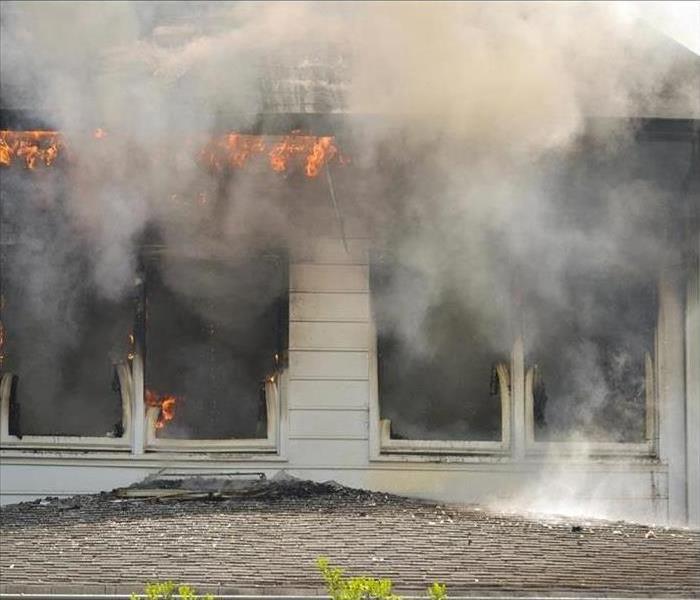 Don't let smoke damage ruin your day!!
Don't let smoke damage ruin your day!!
Are you one of the 1.3 million people each year that has had a home fire? How will you ever get rid of that smell? OZONING! What is ozoning and how does it work?
Normal oxygen (O2) is converted to O3, which is commonly called ozone. It reverts back to O2 in about an hour if the O3 is unused. This leaves the air fresh and clean because the source of the order has been permanently removed. And there are no artificial odors so the space becomes free of odors, as nature intended.
Outdoors, nature eliminates odors and microorganisms using UV light and O3. Indoors, most places receive very little UV light or O3 to help eliminate the odors. An ozone machine creates O3, or ozone, in a process that utilizes an electrical current. Ozone sanitizes the air by breaking down odors and microorganisms at their source.
Nature creates O3 as a natural cleaning during thunderstorms, and also from the sunlight striking the earth’s atmosphere. We have all taken a walk after a thunderstorm and experienced that fresh clean, fresh smell in the air. That’s O3, or ozone, at work.
SERVPRO also offers a service at our facility where we can ozone specific items like clothing, furniture, or anything that has smoke damage and get it smelling better than new.
SERVPRO of North Utah County can restore your home after events involving fire damage!
3/3/2020 (Permalink)
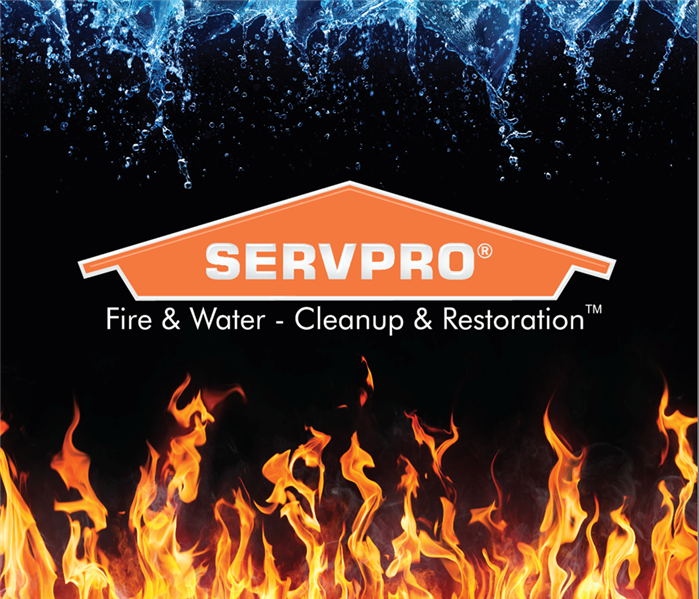 Don't forget to check your cords!!
Don't forget to check your cords!!
When a water line to your refrigerator drips in your Pleasant Grove kitchen, this might seem a minor inconvenience. However, this can cause problems with dry rotting or microbial activity from the water itself, but other issues can also present themselves. Cords to heavy appliances often become nicked and crimped when someone moves them, and sometimes creating tiny breaks in the insulation.
If your refrigerator cord contains such breaks, your home can eventually become victim to Fire Damage in Orem. Electrical fires can melt the exterior of the appliance that caused the fire, as well. We can mitigate all of the damage caused by such fires and get your home wholly restored. Our employees are certified by the IICRC and understand the complexities that can result from such fires.
Electrical shock can pose a risk when trying to put out such a fire. Always shut off the electricity at the breaker before attempting to extinguish a small fire like this. More massive fires require you to evacuate your home and call the fire department from a phone outside of your home. Staying safe in an emergency can seem difficult when valuable items tempt you to return for their removal. However, calling emergency services can save your life. We can help you restore the majority of your belongings.
Items that were located in other areas of your home can become covered in a film from the fire. When plastic composites burn, greasy soot spews out of the fire, covering everything in your home. We get to work cleaning this away from your belongings and home furnishings. Allowing it to settle allows it to cause finishes to become ruined. We clean small items at our facility after boxing them up and restore larger ones at your home. We compile inventory sheets to allow you to find anything we take away from your home. These same sheets can help you return items to their original location, as well.
SERVPRO of Utah County can restore your home after events involving fire damage, as well as other disasters. Our number, (801) 785-5228, puts you in contact with our caring professionals 24 hours a day, every day of the year.
Smoke Alarm Safety for your home.
1/14/2020 (Permalink)
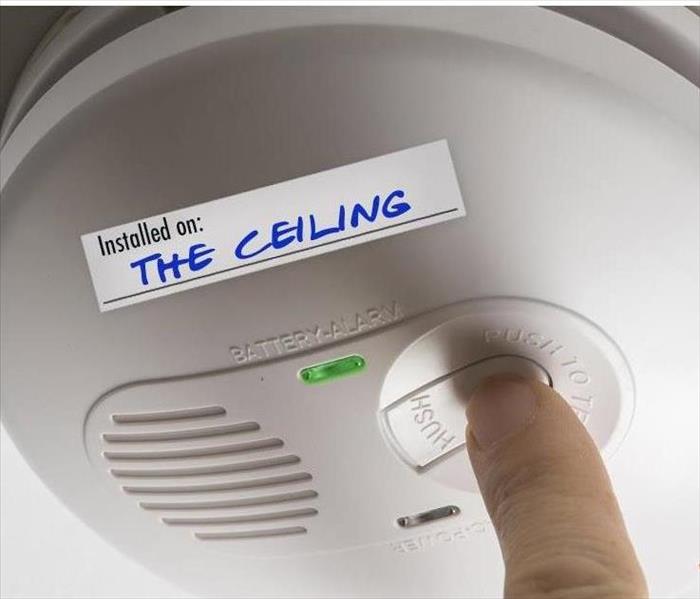 Smoke alarms save lives!!
Smoke alarms save lives!!
Smoke alarms save lives. Smoke alarms that are properly installed and maintained play a vital role in reducing fire deaths and injuries. If there is a fire in your home, smoke spreads fast and you need smoke alarms to give you time to get out. SERVPRO wants you to stay safe.
Here's what you need to know
- A closed-door may slow the spread of smoke, heat, and fire. Install smoke alarms in every sleeping room and outside each separate sleeping area. Install alarms on every level of the home.
- Smoke alarms should be interconnected. When one sounds, they all sound.
- Larger homes may need extra smoke alarms.
- Test your smoke alarms at least once a month. Press the test button to be sure the alarm is working. If the alarm still does not work replace the batteries, and if it still doesn’t work replace it.
- There are two kinds of alarms. Ionization smoke alarms are quicker to warn about flaming fires. Photoelectric alarms are quicker to warn about smoldering fires. It is best to use both types of alarms in the home.
- When a smoke alarm sounds, get outside and stay outside. Don’t wait
- Replace all smoke alarms in your home every 10 years whether they are still working or not.
Facts about smoke alarms
- Smoke alarms provide an early warning of a fire, giving people additional escape time. In 2012-2016, smoke alarms were present in three-quarters (74%) and sounded in more than half (53%) of the home fires reported to U.S. fire departments.
- Almost three of every five home fire deaths resulted from fires in homes with no smoke alarms (40%) or no smoke alarms that were working (17%).
- The death rate per 1,000 reported home fires was more than twice as high in homes that did not have any working smoke alarms (12.3 deaths per 1,000 fires), either because no smoke alarm was present or an alarm was present but did not operate), as it was in homes with working smoke alarms (5.7 per 1,000 fires).
- In fires in which the smoke alarms were present but did not operate, more than two of every five (43%) of the smoke alarms had missing or disconnected batteries.
- Dead batteries caused one-quarter (25%) of the smoke alarm failures.
For more information on smoke alarms and other fire protection related information visit the website for the National Fire Protection Association.
Avoid a Tragedy This Holiday Season In Your Lehi Home!!
12/18/2019 (Permalink)
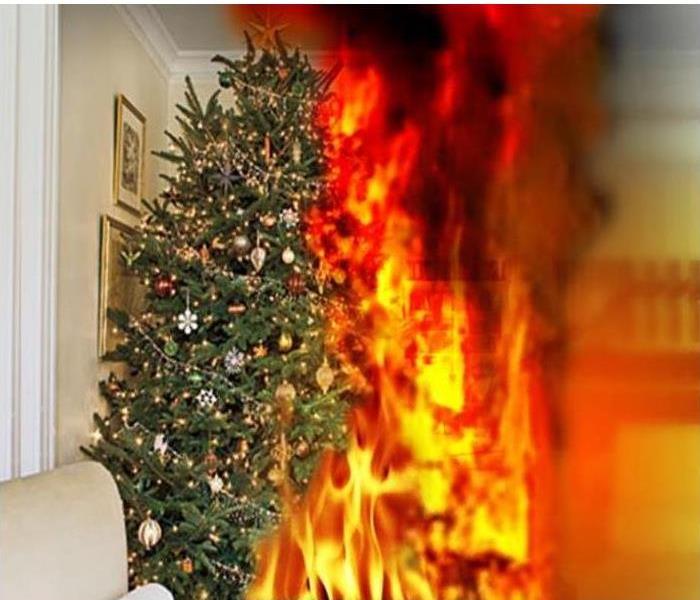 Don't let this disaster happen to you!
Don't let this disaster happen to you!
7 tips for preventing a Christmas tree-related fire
- Pick a fresh tree
- Keep the tree watered
- Keep the tree away from heat
- Shake the tree
- Check the tree lights
- Turn tree off when you’re not home
- Get rid of your tree soon after the holidays
Winter holiday fire facts
- Between 2013-2017, U.S. fire departments responded to an average of 160 home fires that started with Christmas trees per year. These fires caused an average of three deaths, 15 injuries, and $10 million in direct property damage annually.
- On average, one of every 52 reported home fires that began with a Christmas tree resulted in a death, compared to an average of one death per 135 total reported home fires.
- Electrical distribution or lighting equipment was involved in 44% of home Christmas tree fires.
- In one-quarter (25%) of the Christmas tree fires, some type of heat source, such as a candle or equipment, was too close to the tree.
- One-fifth (21%) of Christmas tree fires were intentional.
- Roughly three-quarters of Christmas tree fires occurred in December or January.
- Two of every five (39%) home Christmas tree fires started in the living room.
SERVPRO can help if you find yourself in this type of disaster.
Halloween Fire Safety Tips!
10/1/2019 (Permalink)
Halloween is coming up fast. You’ve heard plenty of urban legends about safety on this night, whether it’s for you or your family. But one factor that might often be overlooked is fire safety. Using fire adds another dimension to your decorations, but as always, you want to be sure it doesn’t get out of control.
- Decorations for special events, most often involving candles, account for an annual average of 800 home fires, causing nearly $4 million in direct property damage, according to NFPA. Additionally, in the United States, more than 100 people die each year as a result of their clothing becoming ignited.
- Purchase only those costumes, wigs and props labeled as flame resistant or retardant. When creating a costume, plan carefully to ensure that it won’t easily ignite if it comes in contact with heat or flame. Costumes should be made without billowing or long trailing features that present a higher risk of ignition. Avoid highly flammable fabrics and accessories.
- Dried flowers, cornstalks and crepe paper catch fire easily. Keep all decorations away from open flames and other heat sources like light bulbs and heaters.
- Remember to keep exits clear of decorations, so nothing blocks escape routes. Make sure all smoke alarms in the home are working
- Tell children to stay away from open flames including jack-o-lanterns with candles in them. Be sure they know how to stop, drop and roll if their clothing catches fire. (Have them practice, stopping immediately, dropping to the ground, covering their face with hands, and rolling over and over to put the flames out.)
- Whenever a fire happens, it’s best to know how to escape it. Any escape routes near your house or in your neighborhood work. Don’t overcrowd your yard in case anyone needs to run away quickly enough.
- Decorations are the first thing to ignite in 900 reported home fires each year. Two of every five of these fires were started by a candle.
SERVPRO wants you to stay safe this Halloween. If you would like to know more information on fire safety please check out the National Fire protection. If you find your home with smoke damage or fire damage please call SERVPRO of North Utah County, we are here to help you.
Why Board Up After a commercial Fire?
8/1/2019 (Permalink)
If your Commercial property in Utah county has experienced a fire, there are several reasons why you might want to board up structural damage or windows. In addition to keeping the external elements out of your home with fire damage, boarding up can also prevent additional losses due to looting and make the fire cleanup process easier.
Boarding Up
Most full-service restoration specialists offer boarding-up services. Here are four reasons to board-up after a fire.
1. The premises still have sustainable inventory. If the building still contains products that appear viable, you should consider boarding. These products may involve evaluation and cleaning and may not be suitable for sale, but it may be useful for insurance reasons to have them correctly processed rather than stolen.
2. You want electronics and other valuables to be protected. You may be able to restore certain electronics or other precious assets to working condition depending on the extent of the fire damage. Loss can be much more costly than repairing or replacing covered.
3. You need to keep out the elements. If the structure of your property has sustained extensive damage, you should try to keep the elements out. Exposure to additional water, wind, or sunlight can compound the damage caused by smoke residue and soot.
4. You want to limit soot damage. It is generally a good idea to reduce foot traffic on the scene of a recent fire. When soot gets embedded into carpeting or upholstery, it can be much more difficult to restore these materials to a pre-fire condition.
Talk to restoration experts at SERVPRO of Utah County, about whether boarding-up is a good strategy for preventing loss and limiting the damage after a fire. Your major concern is likely to be how to recover from fire damage as quickly and completely as possible. Preventing looting and exposure to the elements can make fire cleanup more successful.
Stop, Drop, & Clean the Lint Out from Inside Your Dryer Vent!
5/21/2019 (Permalink)
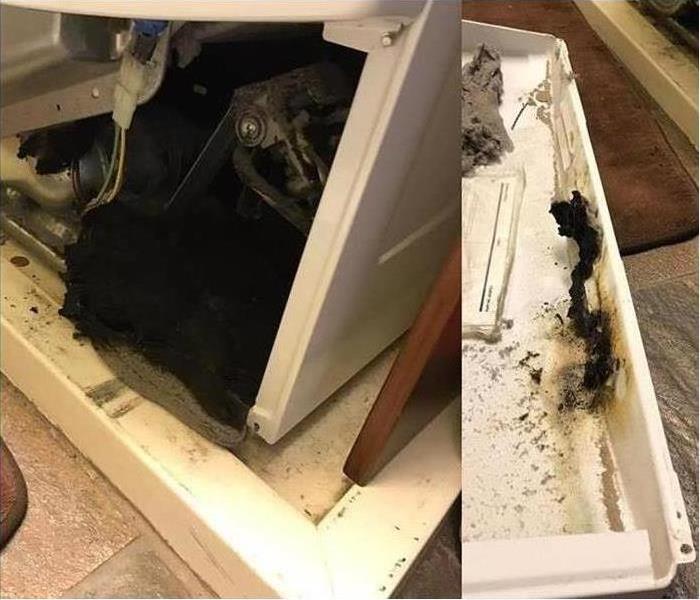 Lints that gets caught and builds up in your dryer vents can cause a fire in your home.
Lints that gets caught and builds up in your dryer vents can cause a fire in your home.
We all know to clean out the lint screen of our dryers, right? Did you know if you aren’t cleaning the lint out of the INSIDE and VENT of your dryer you are putting your family in danger of a house fire? Over time lint will build up and settle in the bottom of your dryer and in your dryer vent. If you don’t clean this out the heat from the dryer can ignite a fire inside your dryer. You know what the boy scouts say, “lint is the great to start a fire”.
Here is an experience from someone who recently had a fire in her dryer and was lucky enough it didn’t start her house on fire.
Counting our blessings today… Last night we smelled something "burning" right as we were going to bed. We thought it was our renters burning food or something in their oven. We had windows open and fans going but didn't really think much of it. Well this afternoon I went to get clothes out of the dryer, they smelled horrible!!! Like a cross between camp fire smoke and cigarette smoke. So, I threw them back in the washer and told my husband. When he got home, we pulled the bottom portion of the dryer off just to check things out. To our amazement (we haven't had this dryer THAT long - but bought it from someone else) there was burnt/singed lint everywhere. There had been a lint fire inside the bottom of our dryer last night. Our house seriously could have caught on fire. I'm so glad it didn't. Hence - we are counting our blessings today and I am spreading the word to all that you should go clean out under your lint catcher thing so your house doesn't start on fire!
Here are a few tips from The Family Handy Man on how to clean the lint out of your dryer.
https://www.familyhandyman.com/appliance-repair/washer-and-dryer-repair/dryer-lint-cleaning-tips/view-all
If you so experience and fire caused by your dyer or any other appliances in your home call SERVPRO today! SERVPRO will come and mitigate the damage, clean up & restore the affected area, and make it “Like it never even happened.”
How to Make a Fire Safety Escape Plan for Your Family
3/10/2019 (Permalink)
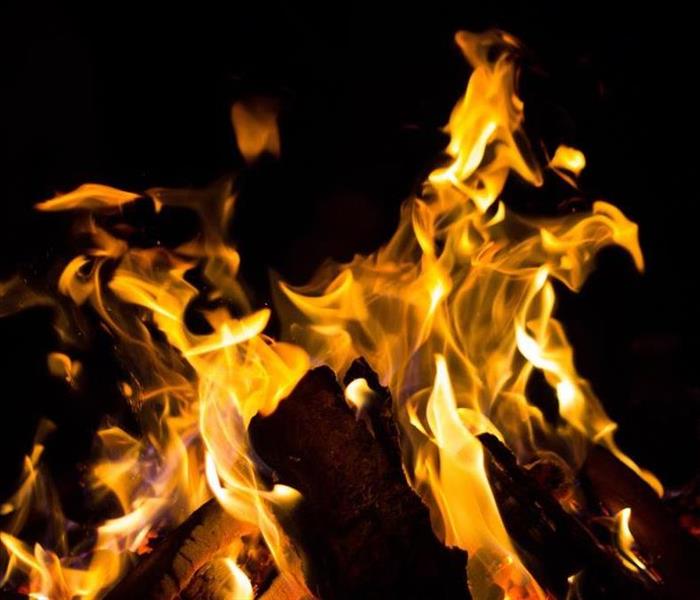 Protect your family in the event of a fire!
Protect your family in the event of a fire!
In 2016 there were an estimated 364,300 reported residential fire and 2,000 fire related fatalities. In the event of fire, TIME is the BIGGEST ENEMY and EVERY SECOND COUNTS! In less than 30 seconds a small flame can turn into a major fire. The most important thing you can do to prepare is have a Safety Escape Plan.
At Home Fire Safety Plan Tips
First and foremost, make sure you have one working smoke alarm on every level of the home, as well as inside and outside each sleeping area.
Have two ways out of each room, and the proper equipment to get out any upper story windows. Walk through each room in your home with your family and point out possible exits. Also, provide alternatives for anyone with a disability.
Once you have established the exits, practice and show children how to get out of the house and check the door for heat before opening it.
Know to crawl low to the floor when escaping to avoid toxic smoke. Practice dropping to your stomach and shimmying out under the smoke with your children.
Make a plan to help pets evacuate safely as well if possible.
Once you are out of the house, STAY OUT. DO NOT go back in the house. There could be unseen damage and danger. Call 911 immediately.
Know where to meet after the escape. Your meeting place should be near the front of your home so firefighters know you are out.
Practice, Practice, Practice your escape plan. It is recommended you practice at least twice a year. If you have young children it may require more than twice. Practicing can save the lives of you and your family.
If you do have a fire in your home call SERVPRO of North Utah County today!
Space Heater Safety In Your Lehi Home
2/26/2019 (Permalink)
Space Heater Safety in Your Lehi Home
Anyone who has paid the bill to heat their home in the winter knows the woes and expense associated with staying warm. In return this is why so many people to turn to their trusty space heater, but is your space heater “trusty”? Did you know upwards of 25,000 house fires and 300 deaths are attributed to space heaters each year? Follow these tips to keep warm and most importantly protect your family and home this winter.
- NEVER leave a space heater unattended. Turn it off when you are leaving a room or going to sleep
- Proper placement of your space heater is crucial! Keep space heaters at least three feet away from anything that is flammable or can burn. This includes curtains, bedding, clothes, papers, etc.
- Select the appropriate space heater for the size of your room. If you are placing the heater in a bedroom or smaller area you only need a heater rated for your space. On the other hand, if you are heating a large area don’t expect to buy a smaller rated heater to heat the entire space. That leads to the over use and can cause the smaller heater to malfunction.
- Keep children and pets away from the space heater. This may sound obvious but many fires are caused be the heater gets covered or tipped into something flammable.
- Place your heater on a hard, flat surface. Most heaters have an auto-shutoff trigger on the bottom but its better to be safe than sorry.
- As a rule of thumb plug directly into an outlet. Do not use an extension cord or power strip, which could overheat and result in a fire.
- Keep space heaters away from water. Refrain from running a space heater in a bathroom or humid room unless you have a bathroom safe model (which will be specified on the box at time of purchase)
Use common sense and be careful so you don’t become one of the 25,000 fires a year caused by space heater.
If you do experience a fire caused by space heater or anything else call SERVPRO of North Utah County. As Fire and Water Damage Specialists, we have the experience, the expertise, and the advance training that enables us to get your property restored quickly and thoroughly.
https://www.SERVPROofnorthutahcounty.com/fire-smoke-damage-restoration
What Can You Do Until Help Arrives After a Fire in Your American Fork Home?
2/7/2019 (Permalink)
What you can do until help arrives after a Fire in your American Fork home
After any fire damage situation, your primary focus should be safety:
Is it safe to stay in the house? In most cases it is not safe to stay in the house. Get your self and your family out and stay out until you have permission from the local fire department to re-enter the home. There could be unseen damage and danger lurking around the corner.
Electrical and "slip and fall" hazards are some of the most prevalent concerns. After electrical equipment is exposed to water it can become extremely hazardous if re-energized. You might also be surprised to hear that electrical equipment exposed to the smoke/soot is equally hazardous.
Wet materials can be VERY heavy. Be careful! You may think it is a good idea to start to clean up but wet materials are extremely heavy and you can injure yourself very easily.
Have A Fire or Smoke Damage Emergency?
Call SERVPRO of North Utah County 801-785-5228
What To Do After A Fire
- Limit movement in the home to prevent soot particles from being embedded into upholstery and carpets.
- Keep hands clean so as not to further soil upholstery, walls and woodwork.
- Place clean towels or old linens on rugs, upholstery and carpet traffic areas.
- If electricity is off, empty freezer and refrigerator and prop doors open.
- Clean and protect chrome with light coating of petroleum jelly or oil.
- Wash houseplants on both sides of leaves.
- Change HVAC filter.
- Tape double layers of cheesecloth over air registers.
What NOT To Do After A Fire
- Don't attempt to wash any walls or painted surfaces or shampoo carpet or upholstery without contacting your SERVPRO of North Utah County.
- Don't attempt to clean any electrical appliances that may have been close to fire, heat or water without consulting an authorized repair service.
- Don't use any canned or packaged food or beverages that may have been stored near the fire, heat or water.
- Don't turn on ceiling fixtures if ceiling is wet. The wiring may be damaged.
- Don't send garments to an ordinary dry cleaner. Improper cleaning may set smoke odor.
Learn How SERVPRO Can Restore Your Pleasant Grove Home After A Fire
1/16/2019 (Permalink)
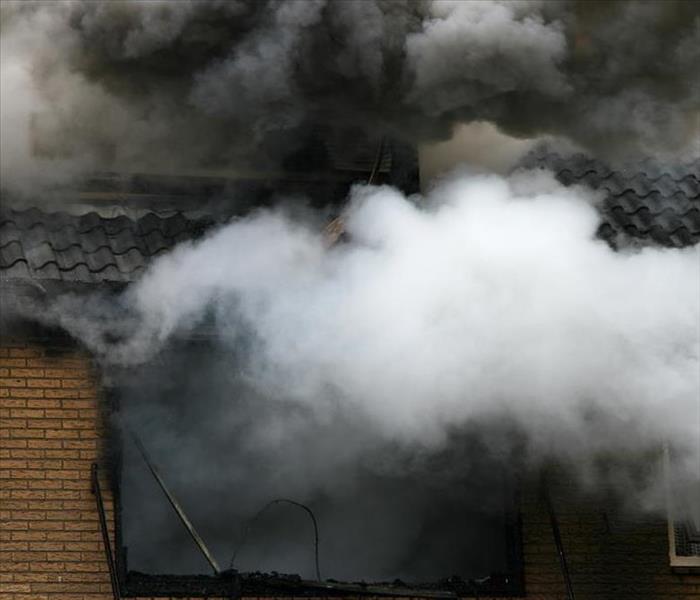 Fire Damage can leave you helpless call only the certified experts at SERVPRO for professional restoration.
Fire Damage can leave you helpless call only the certified experts at SERVPRO for professional restoration.
Odor Control Crucial After Fire Damage in Your Pleasant Grove Residence
One thing that heat does to something is it changes the chemical structure. Direct heat, such as a fire in a home in Pleasant Grove, produces many different changes, both chemical and physical. During the time these changes take place, affected materials give off microscopic particles.
When a home in Pleasant Grove or its contents burns, fire damage includes the effects caused by the multitude of particles given off during the blaze. These tiny substances float around the house, carried in the smoke, as well as in the steam created when firefighters' water hits hot and burning areas, and land everywhere. These continually disintegrate, and as they do, air currents already present in the home pull them back into the air you and your family breathe.
The specialists from SERVPRO eliminate the majority of these particles during standard soot cleanup procedures. The ones that find their way into cracks and crevices or the tiny spaces under cabinets and inside empty spaces between walls often remain where they fell, though, because we do not want to tear apart these structures to remove the soot.
Instead, we use different methods to remove them and the odors they cause. During fire damage mitigation, we often use machines that generate hydroxyl. This process is so safe that many food industry factories also use it on a daily basis. The only problem with this is that it does not remove particles that have yet to disintegrate enough and remain hidden.
Our IICRC-certified Odor Control Technician (OCT) uses other odor control techniques. After we complete the mitigation tasks your home requires, we can begin looking at odor control techniques. One that often provides the necessary odor control levels most homeowners desire is thermal fogging. Because this method produces a heated fog that travels throughout the home in the same way the smoke during the fire traveled, it reaches those areas hiding soot particles.
The chemicals in the fog combine with the soot and make the particles too heavy and stop them from disintegrating any more. The presence of these particles is what causes the odors your family smells when they enter the home. Thermal fogging, as well as strategically placed gel packs and injectable deodorizing liquids into upholstered furniture and carpets, makes your home's interior pleasant again, “Like it never even happened.”
SERVPRO of North Utah County can quickly erase the fire damage in your Highland, Cedar Hills, or Draper home and make it livable again. Call us at (801) 785-5228.
Click here to find more information on how to enter to win Miss Pleasant Grove.
SERVPRO Will Put The Flames Of Worry Out In Your Pleasant Grove Home After A Fire
1/7/2019 (Permalink)
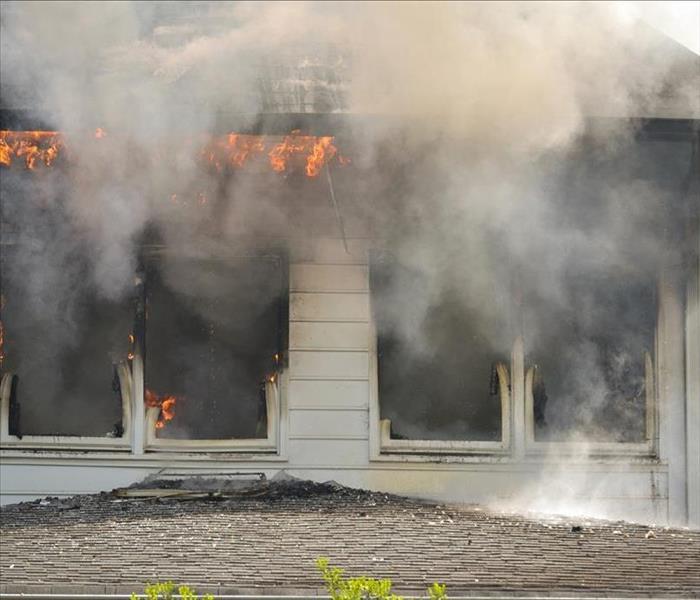 SERVPRO has the right equipment to restore your home after a fire.
SERVPRO has the right equipment to restore your home after a fire.
Deodorizing Clothing After a Fire in Your Pleasant Grove Home
Taking care of your belongings after a fire can be a challenging thing to do, especially when you already have structural concerns with your Pleasant Grove property to face. With smoke damages, many surfaces and materials can get affected, even those far away from the initial blaze. Restoring these items and areas requires specialized tools and equipment designed to deodorize your belongings and property to substantially reduce or permanently eliminate lingering smoke and charring odors.
When you consider your options for fire odor removal in your Pleasant Grove home, many area homeowners consider this to be a lower priority to restoring structural concerns to their house. Our SERVPRO professionals can work quickly to assess all of the effects from the fire and devise a plan to overcome each of these effects individually to restore your home to original condition.
While many structure fires require demolition and later reconstruction efforts, removing odor effects to items like your clothing does not have to be so invasive. Our equipment, like our thermal foggers, can emit a dense chemical compound that affects these softer materials and seeps into their molecular structure to break apart foul odor molecules trapped in the fabric. Our SERVPRO technicians can also use dry cleaning techniques for furniture, clothing, and carpeting to remove residue and the lingering odor.
This same deodorizing technique can get used on open areas of the home that also have a lingering foul scent. Our equipment works quickly to help improve the indoor air quality, especially when it gets combined with the purifying efforts of other tools like our air scrubbers or hydroxyl generators. Combined, these machines can eliminate the presence of smoke damage in the air throughout the affected areas of your home.
Smoke damage can be challenging to overcome in your house without the appropriate equipment and experienced professionals like our SERVPRO of North Utah County fire restoration specialists. You can count on our rapid response to help you assess the damage and get to work quickly on restoring your home entirely. Give us a call anytime at (801) 785-5228.
Click Here to download the 2019 Miss Pleasant Grove application due on March 16, 2019.
Advanced Techniques and Technologies to Restore Fire Damage in Provo
9/4/2018 (Permalink)
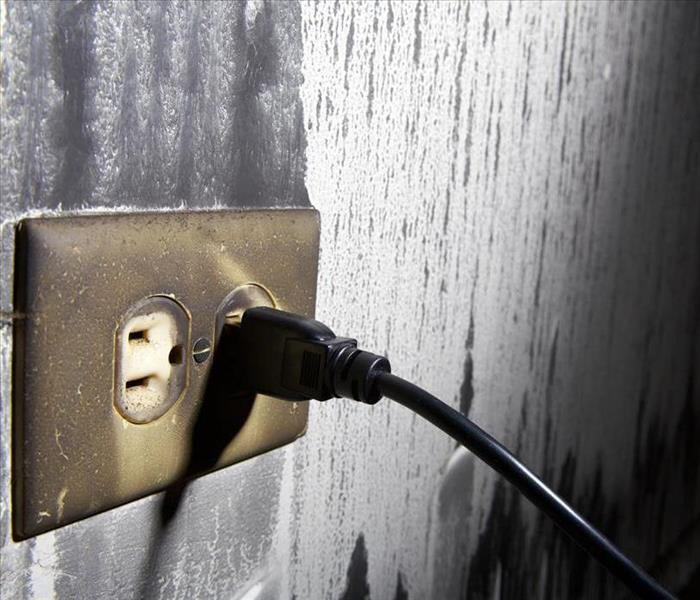 Provo Soot Stained Homes Rely on SERVPRO for House Fire Cleanup
Provo Soot Stained Homes Rely on SERVPRO for House Fire Cleanup
SERVPRO's Fleet and Facility House Industry-Leading Fire and Smoke Damage Cleanup Equipment, Tools, and Products
Household fire disasters have challenged humans for thousands of years, but fortunately for fire victims in Provo, the strategies used to recover have evolved. There are many reasons to rely on professional assistance when recovering from a fire. The up to date equipment and continuously refined techniques our technicians have at their disposal are excellent rationales to hire our fire damage specialists.
After a fire damages your Provo home, the need for cleanup and restoration can be significant. The first task is often water removal and structural drying because of firefighting efforts. Our technicians receive certification from the IICRC to respond to both water and fire damage, streamlining the process. Commercial grade pumps, water extractors, air movers, heaters, and dehumidifiers are standard equipment on our service vehicles, allowing our crew to begin work immediately after the project manager assesses the damage.
Clean up of smoke and soot damage involves working with toxic residues. SERVPRO crew members complete training guiding them on how to complete the cleaning tasks safely, including the use of containment equipment in severe scenarios. We can protect areas of your home unaffected or only slightly damaged through the use of negative pressure air scrubbers that seal off the spaces as we clean them, filtering the air and preventing debris from spreading further.
Because smoke and soot are airborne and have a head start during the chaos of the fire, they frequently make their way far from the burned area. The damage can be invisible to the untrained eye, but SERVPRO employees know what to seek and where the harm often occurs. If this “invisible” damage is ignored, the result is progressive deterioration and increased costs to the homeowner. Our crews use appropriate products and tools to clear away the hidden fire damage, following industry protocols that avoid worsening the scenario.
The SERVPRO production facility has specially trained technicians and a range of cutting-edge equipment and resources to restore various items of personal property, furnishings, window coverings, and documents. Immersion and ultrasonic cleaning tubs and commercial grade laundry facilities, including the Esporta Wash System, are highly effective resources for intricate hardware and fixtures and clothing and soft items. We create and maintain a detailed inventory when we transport items to our base and work closely with your insurance as we complete all fire damage recovery tasks.
SERVPRO of North Utah County offers many solutions to members of our community struggling to recover from fire damage. Call (801) 785-5228 as soon as authorities release your property to arrange an assessment and to get the restoration process going.
Click here for the local fire department
After a Fire: What you can do until help arrives?
6/12/2018 (Permalink)
After any fire damage situation, your primary focus should be safety:
- Is it safe to stay in the house?
- Electrical and "slip and fall" hazards are some of the most prevalent concerns.
- Only do activities that are safe for you to perform.
- Wet materials can be VERY heavy. Be careful!
What To Do After A Fire
- Limit movement in the home to prevent soot particles from being embedded into upholstery and carpets.
- Keep hands clean so as not to further soil upholstery, walls and woodwork.
- Place clean towels or old linens on rugs, upholstery and carpet traffic areas.
- If electricity is off, empty freezer and refrigerator and prop doors open.
- Clean and protect chrome with light coating of petroleum jelly or oil.
- Wash houseplants on both sides of leaves.
- Change HVAC filter.
- Tape double layers of cheesecloth over air registers.
What NOT To Do After A Fire
- Don't attempt to wash any walls or painted surfaces or shampoo carpet or upholstery without contacting your SERVPRO Franchise Professional.
- Don't attempt to clean any electrical appliances that may have been close to fire, heat or water without consulting an authorized repair service.
- Don't use any canned or packaged food or beverages that may have been stored near the fire, heat or water.
- Don't turn on ceiling fixtures if ceiling is wet. The wiring may be damaged.
- Don't send garments to an ordinary dry cleaner. Improper cleaning may set smoke odor.
What is Our Fire Damage Restoration Process?
4/1/2018 (Permalink)
After the fire trucks leave, your home likely suffers from fire and smoke damage and extensive water damage from firefighting efforts. SERVPRO Franchise Professionals have the specialized fire restoration training needed to restore your home to pre-fire condition.
Every fire damage event is a little different, and requires a unique solution, but the general process stays the same. The steps listed below illustrate our process for the “typical” fire damage emergency.
Step 1: Emergency Contact
The restoration process begins when you call the SERVPRO National Call Center, which is staffed 24 hours a day. Our representative will ask a series of questions regarding the fire damage event that will help us dispatch the nearest SERVPRO Franchise Professional with the appropriate equipment and resources.
Step 2: Inspection and Fire Damage Assessment
Our Professionals will carefully inspect and test adjoining rooms of your property to determine the extent of the fire, smoke, and soot damage. This step is crucial to developing a plan of action.
Step 3: Immediate Board-Up and Roof-Tarp Service
Fire damage can often compromise windows, walls, and roofs. To maintain security and to protect against further damage, the SERVPRO Franchise Professional can board up missing windows and walls and place tarps on damaged roofs.
Step 4: Water Removal and Drying (if water damage is present)
The water removal process begins almost immediately and removes the majority of the water. They will then use dehumidifiers and air movers to remove the remaining water and complete the drying process.
Step 5: Removal of Smoke and Soot from All Surfaces
The SERVPRO Franchise Professionals use specialized equipment and techniques to remove smoke and soot from ceilings, walls, and other surfaces.
Step 6: Cleaning and Sanitizing
They will clean all of the restorable items and structures that were damaged by the fire. They use a variety of cleaning techniques to restore your belongings to pre-fire condition. They’re also trained to remove odors using industrial air scrubbers and fogging equipment.
Step 7: Restoration
Restoration is the final step—getting your home or business to its pre-fire condition. Restoration may involve minor repairs, such as replacing drywall, painting, and installing new carpet; or it may entail major repairs such as the reconstruction of various areas or rooms in a home or business.
The Importance of Smoke Alarms
1/25/2018 (Permalink)
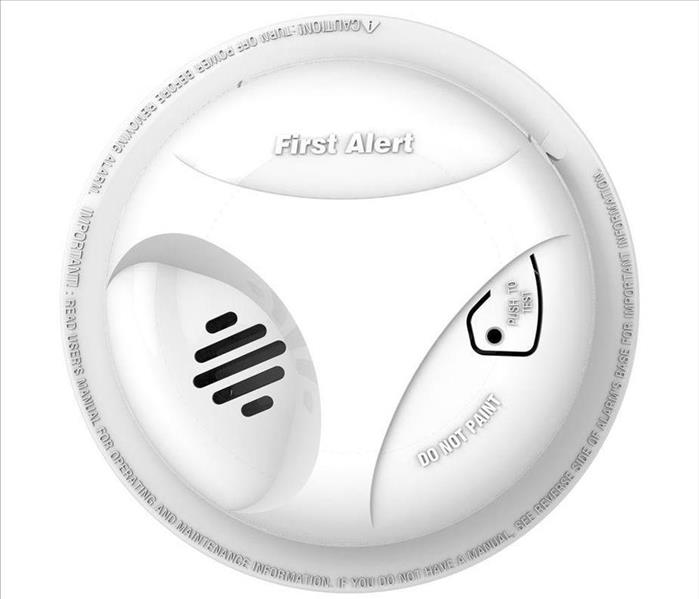 Don't Wait, Check Yours Today
Don't Wait, Check Yours Today
Smoke Alarms Save Lives
Let’s get straight to the point Smoke alarms save lives. Smoke alarms that are properly installed and maintained play a vital role in reducing fire deaths and injuries. If there is a fire in your home, smoke spreads fast and you need smoke alarms to give you time to get out.
Here's what you need to know
- A closed door may slow the spread of smoke, heat, and fire. Install smoke alarms in every sleeping room and outside each separate sleeping area. Install alarms on every level of the home.
- Smoke alarms should be interconnected. When one sounds, they all sound.
- Larger homes may need extra smoke alarms.
- Test your smoke alarms at least once a month. Press the test button to be sure the alarm is working. If the alarm still does not work replace the batteries, and if it still doesn’t work replace it.
- There are two kinds of alarms. Ionization smoke alarms are quicker to warn about flaming fires. Photoelectric alarms are quicker to warn about smoldering fires. It is best to use of both types of alarms in the home.
- When a smoke alarm sounds, get outside and stay outside. Don’t wait, the life you and your family may be on the line.
- Replace all smoke alarms in your home every 10 years whether they are still working or not.
Facts and figures about smoke alarms
- In 2009-2013, smoke alarms sounded in more than half (53%) of the home fires reported to U.S. fire departments.
- Three of every five home fire deaths resulted from fires in homes with no smoke alarms (38%) or no working smoke alarms (21%).
- No smoke alarms were present in almost two out of every five (38%) home fire deaths.
- The death rate per 100 reported home fires was more than twice as high in homes that did not have any working smoke alarms compared to the rate in homes with working smoke alarms
- In fires in which the smoke alarms were present but did not operate, almost half (46%) of the smoke alarms had missing or disconnected batteries.
- Dead batteries caused one-quarter (24%) of the smoke alarm failures.
The moral of the story is make sure you have the proper number of smoke alarms in your home and they are all properly working.
For more information on smoke alarms and other fire protection related information visit the website for National Fire Protection Association.
https://www.nfpa.org
We can help you "restore not replace" after a fire
1/23/2018 (Permalink)
You've just had one of the worst days of your life due to a house fire and you finally get to go in and inspect the damage. Luckily the fire started in the kitchen and the fire department got there before the whole house went up in flames... but the entire house is now filled with smoke and soot. As well as all of your belongs, they are covered and stinky. Did you know that SERVPRO can help with that? We can get rid of the smoke smell and clean your belongings!
Contents Restoration
SERVPRO specializes in restoring contents damaged by water, fire, or mold. Our expertise and “restore” versus “replace” mentality can help you save money while preserving precious keepsakes that can’t be replaced. We pretest your belongings to determine what items we can restore to pre-fire condition. We use several methods of cleaning your contents, including:
- Dry Cleaning - Used for cleaning light residues or to pre-clean prior to wet cleaning.
- Wet Cleaning - An effective cleaning method for removing moderate to heavy residues.
- Spray and Wipe -Effective for items that can’t withstand wet cleaning.
- Foam Cleaning - Used for upholstery fabrics that might shrink or bleed if wet cleaned.
- Abrasive Cleaning - Involves agitation of the surface being cleaned.
- Immersion Cleaning - Contents are dipped into a bath of the cleaning product.
Getting Rid of the Smoke Smell
12/7/2017 (Permalink)
Are you one of the 1.3 million people each year that has had a home fire? What do you do now? How will you ever get rid of that smell? OZONING! What is ozoning and how does it work?
Normal oxygen (O2) is converted to O3, which is commonly called ozone. It reverts back to O2 in about an hour if the O3 is unused. This leaves the air fresh and clean because the source of the order has been permanently removed. And there are no artificial odors so the space becomes free of odors, as nature intended.
Outdoors, nature eliminates odors and microorganisms using UV light and O3. Indoors, most places receive very little UV light or O3 to help eliminate the odors. An ozone machine creates O3, or ozone, in a process that utilizes an electrical current. Ozone sanitizes the air by breaking down odors and microorganisms at their source.
Nature creates O3 as a natural cleaning during thunderstorms, and also from the sunlight striking the earth’s atmosphere. We have all taken a walk after a thunderstorm and experienced that fresh clean, fresh smell in the air. That’s O3, or ozone, at work.
SERVPRO also offers a service at our facility where we can ozone specific items like clothing, furniture, or anything that has smoke damage and get it smelling better than new.






 24/7 Emergency Service
24/7 Emergency Service




